Laurent Montaron
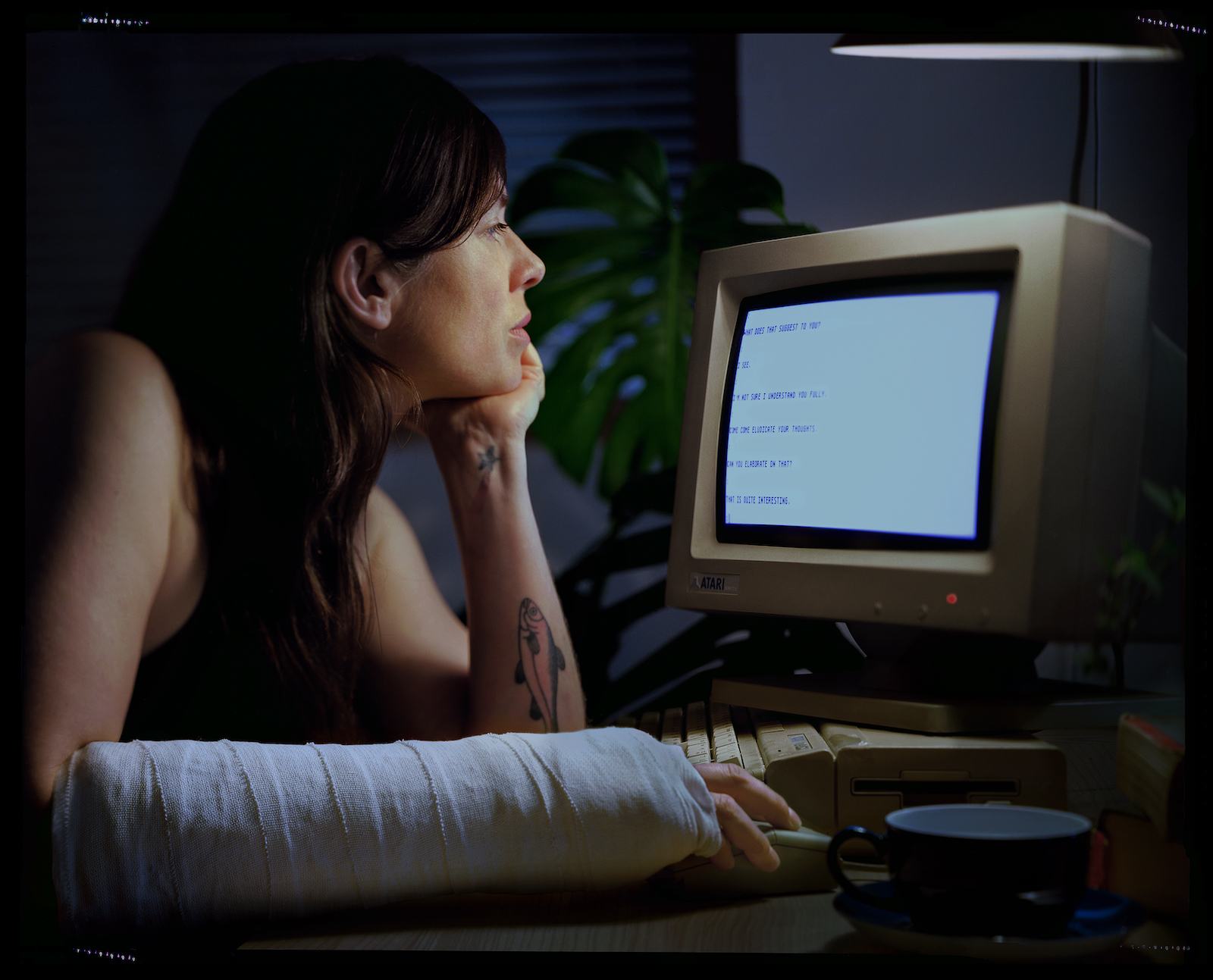
Image: 105 x 130 cm
Frame: 109 x 134 cm
Designed by the German-American computer scientist Joseph Weizenbaum in the mid- 1960s, ELIZA reproduces an interaction with a non-directive psychotherapist, in particular by reformulating the statements made by the user in question in order to continue the dialogue. Operating on a system of pattern recognition and keyword substitution, the programme can give the illusion of mutual understanding, leading some users to attribute human feelings to it. This phenomenon, known as the ELIZA effect, illustrates the human tendency to attribute to machines an intelligence that they do not have. A precursor to modern conversational agents
and artificial intelligence systems, the creation of ELIZA paved the way for decades of research and development in the field of human-machine communication, laying the foundations for the technologies we use today.
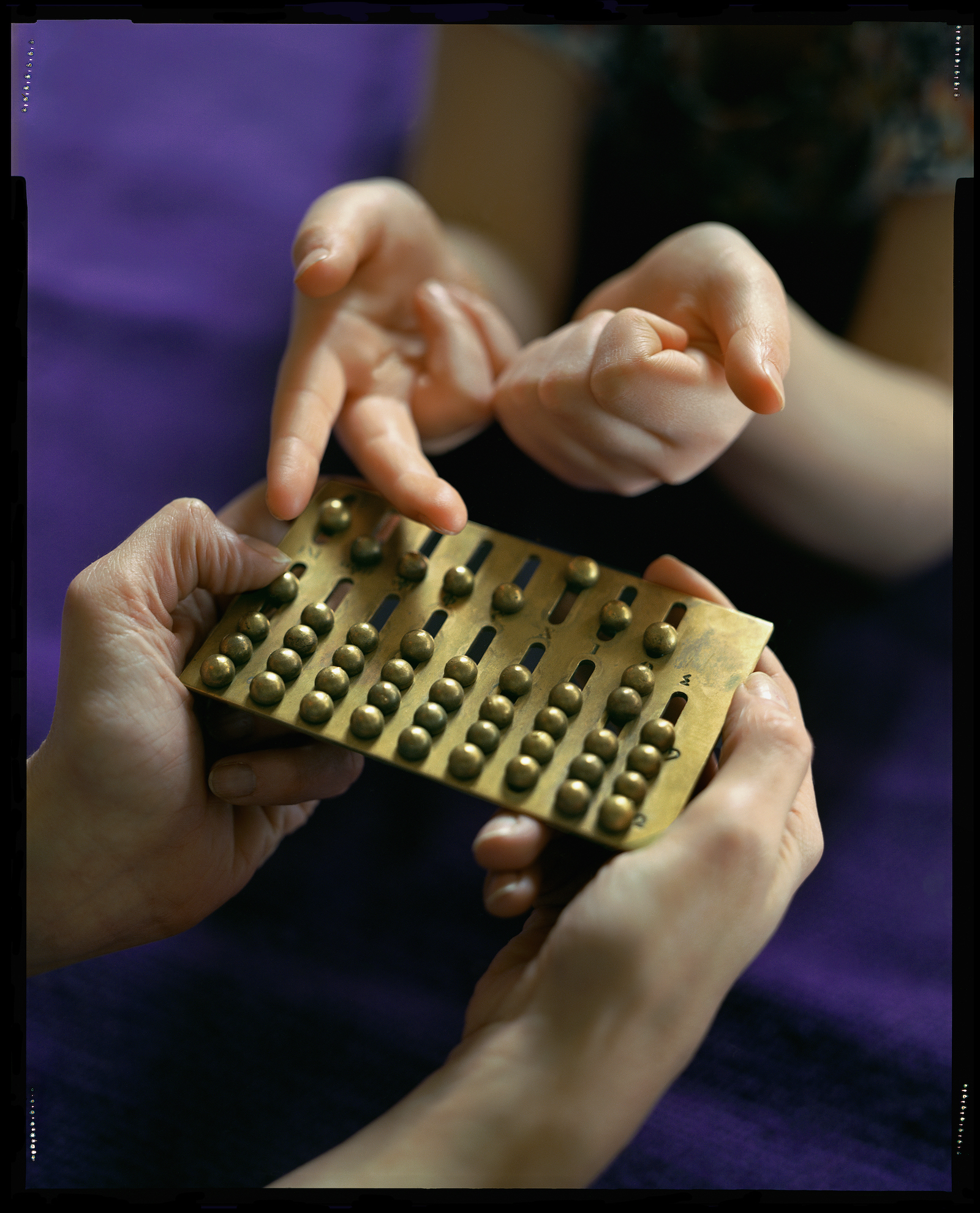
Image: 130 x 105 cm
Frame: 134 x 109 cm
The Roman abacus was a portable mechanical calculating instrument developed around the 1st century AD. It follows in the footsteps of a vast line of arithmetic tools, from the Ishango bones, counting sticks dating back more than 20,000 years and discovered in the Congo, to pebble-based systems ("calculus" means small pebble in Latin) and sand-covered tables on which figures are drawn (abacus literally translates as dust table) found throughout the world. These analogue calculation mechanisms, by materialising complex arithmetic operations, enabled major advances to be made, such as determining the earth's circumference or studying the trajectory of stars. Even today, different forms of abacus are at the heart of competitive mental arithmetic.

Image: 105 x 130 cm
Paper: 109 x 134 cm

Image: 130 x 105 cm
Frame: 134 x 109 cm
Before development, Ektachrome slide films are green monochromes. This color is the result of the overlay of 18 emulsions on a transparent plastic support of 0.18 mm in thickness in an assembly designed for the film to record the world in its own unique way.

Photography, pigment print on Hahnemühle FineArt Baryta paper
Image: 130 x 105 cm
Frame: 134 x 109 cm
In the early days of photography, photographers would craft and apply the emulsion for their images themselves. Then, quickly, they were offered a multitude of ready-to-use supports for both shooting and printing. The brand, packaging, or slogan of these supports, promising particular contrasts, depth, or tones, became synonymous with unique perspectives on the world.
The series "Sun-Exposed Papers" presents packages of black-and-white photographic papers from the 1920s intended to be exposed under an enlarger and developed using a developer (silver gelatin bromide paper from Grieshaber) or designed for contact printing, darkening in sunlight (Grieshaber citrate paper, Lumière & Jougla, Cellofix).
The papers, preserved away from light for over a hundred years, are photographed here as they are being unpacked in full sunlight.
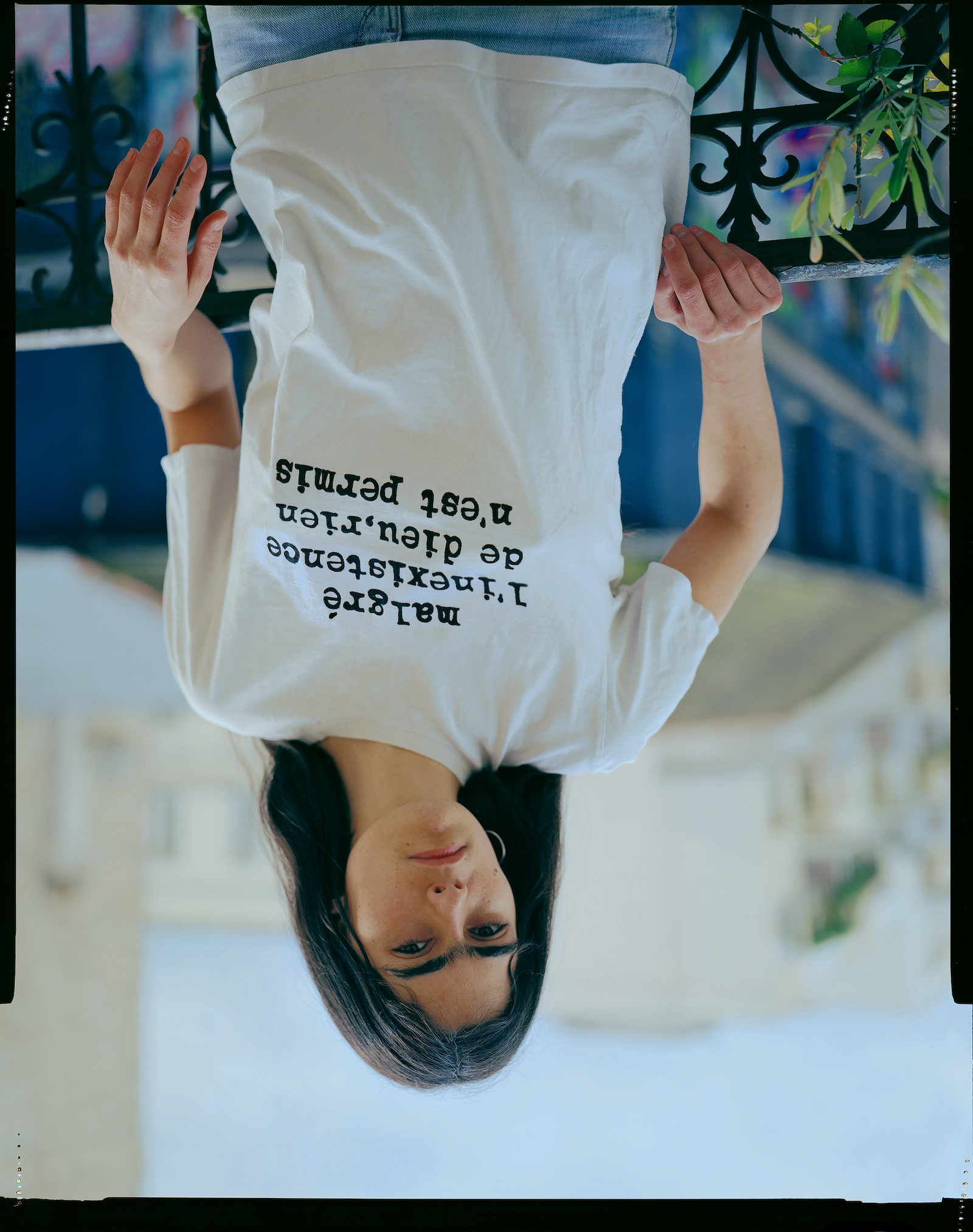
Image: 130 x 105 cm
Frame: 134 x 109 cm
The phrase «Malgré l'inexistence de dieu, rien n'est permis» («Despite the non-exis-
tence of God, nothing is allowed») originated in a silkscreen poster from a collec-
tion of brochures, leaflets, facsimiles and newspaper adaptations produced by the
group «Pour une critique révolutionnaire» («For a revolutionary critique»), formed
during the events of 1968 by Roger Langlais, Guy Bodson and Bernard Pécheur.
Resonating with the Situationist ideas of reappropriation, this poster turned Dos-
toyevsky's maxim «If God didn't exist, everything would be allowed» on its head,
and appeared as an invitation to collectively redefine the norms of society. Today,
the re-enacted image is tinged with the disillusionment of the utopias of the late
twentieth century and the resurgence of religious beliefs. Presented side by side,
Ciel d'Elée and Malgré- linexistencededieurienestpermis link the earliest attempts
at emancipation from a divine narrative with the most recent, tracing a continuity
from one revolution to the next.
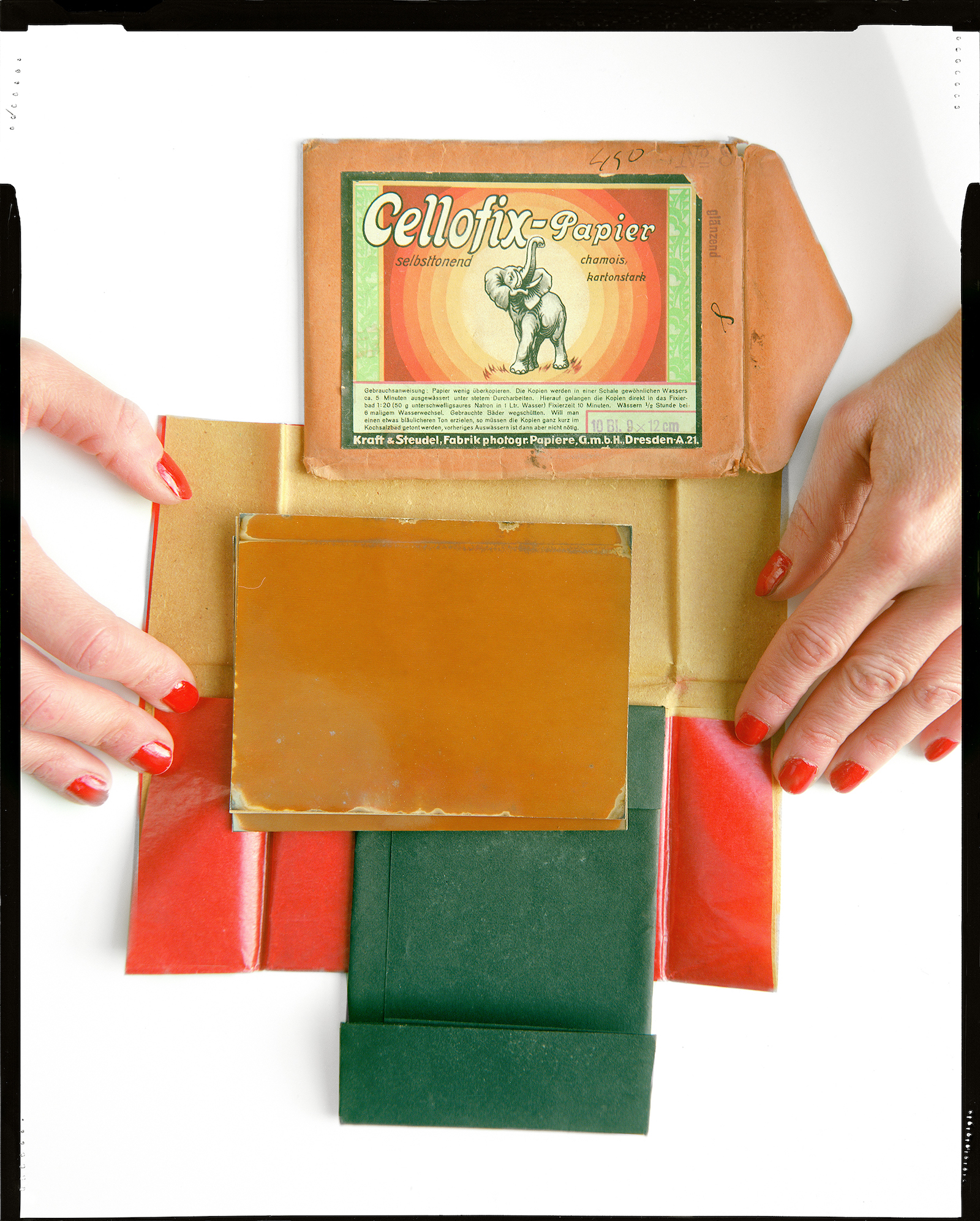
Photography, pigment print on Hahnemühle FineArt Baryta paper
Image: 130 x 105 cm
Frame: 134 x 109 cm
In the early days of photography, photographers would craft and apply the emulsion for their images themselves. Then, quickly, they were offered a multitude of ready-to-use supports for both shooting and printing. The brand, packaging, or slogan of these supports, promising particular contrasts, depth, or tones, became synonymous with unique perspectives on the world.
The series "Sun-Exposed Papers" presents packages of black-and-white photographic papers from the 1920s intended to be exposed under an enlarger and developed using a developer (silver gelatin bromide paper from Grieshaber) or designed for contact printing, darkening in sunlight (Grieshaber citrate paper, Lumière & Jougla, Cellofix).
The papers, preserved away from light for over a hundred years, are photographed here as they are being unpacked in full sunlight.
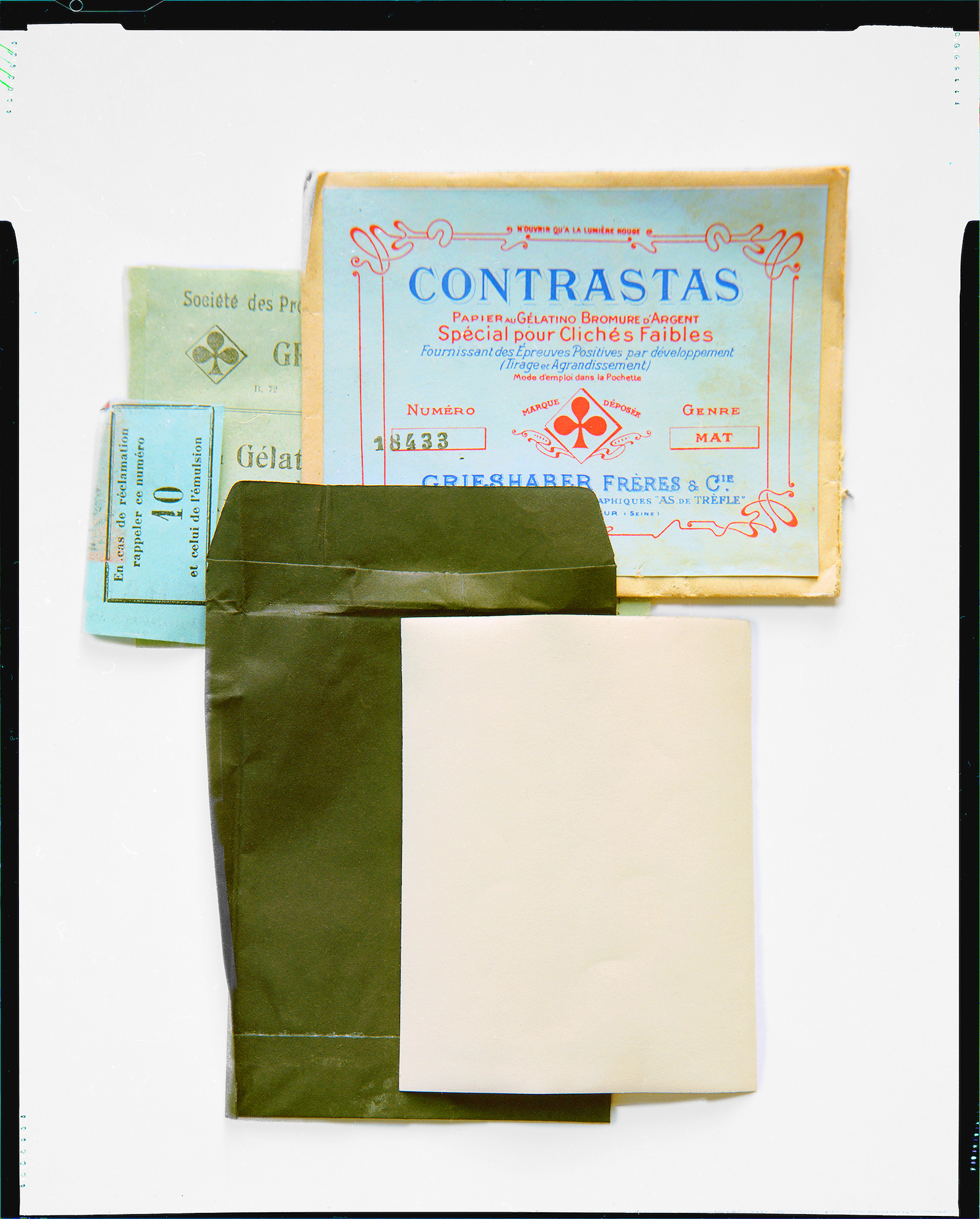
Photography, pigment print on Hahnemühle FineArt Baryta paper
Image: 130 x 105 cm
Frame: 134 x 109 cm
In the early days of photography, photographers would craft and apply the emulsion for their images themselves. Then, quickly, they were offered a multitude of ready-to-use supports for both shooting and printing. The brand, packaging, or slogan of these supports, promising particular contrasts, depth, or tones, became synonymous with unique perspectives on the world.
The series "Sun-Exposed Papers" presents packages of black-and-white photographic papers from the 1920s intended to be exposed under an enlarger and developed using a developer (silver gelatin bromide paper from Grieshaber) or designed for contact printing, darkening in sunlight (Grieshaber citrate paper, Lumière & Jougla, Cellofix).
The papers, preserved away from light for over a hundred years, are photographed here as they are being unpacked in full sunlight.
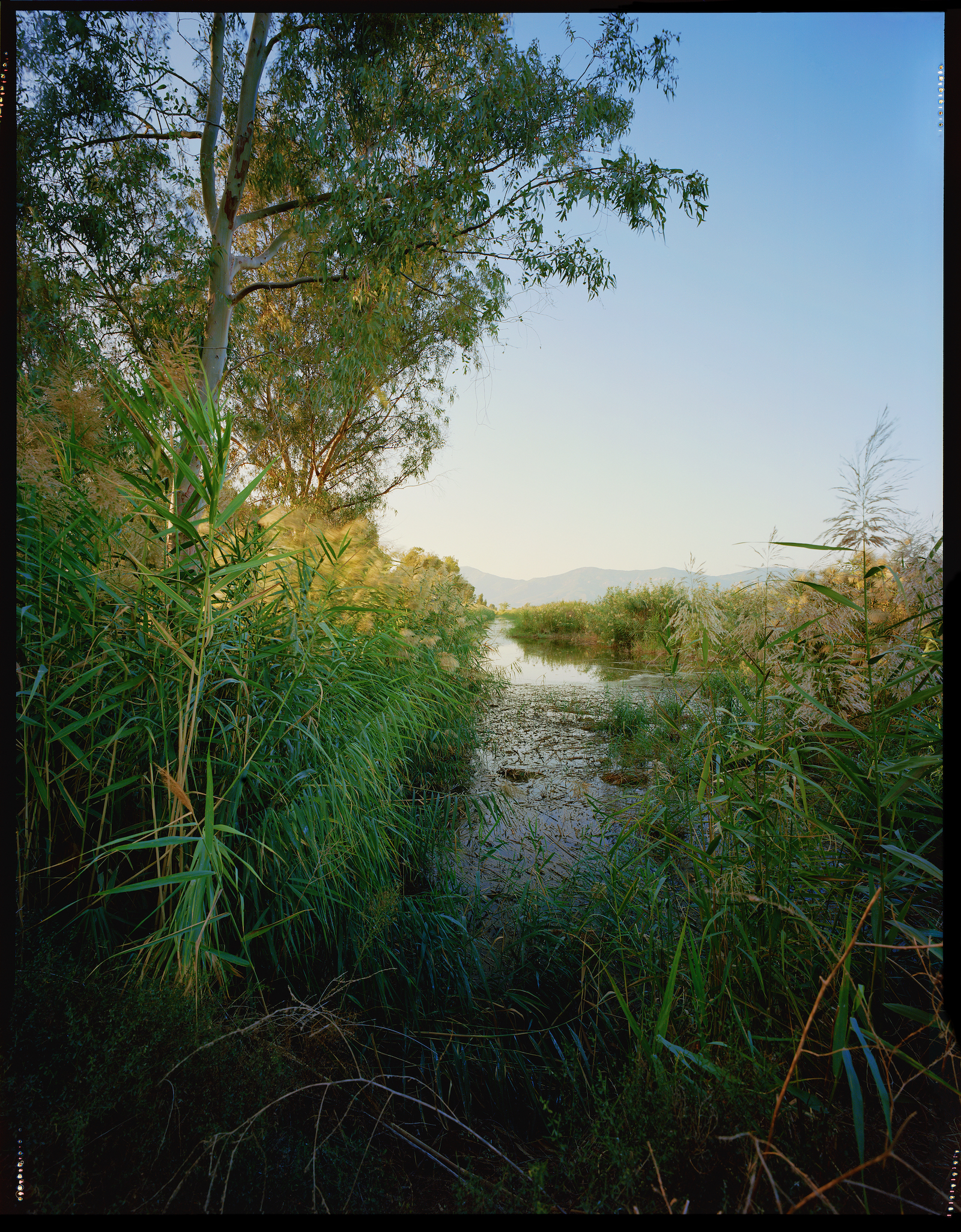
Image: 130 x 105 cm
Frame: 134 x 109 cm
Ephesus, in what is now western Turkey, is an ancient Greek city bordered by two
rivers that flow into the Aegean Sea. It was here, between the Caÿstre and the
Meander, that the philosopher Heraclitus lived in the fifth century BC. We know
his thought only through a hundred or so quotations, often brief and enigmatic, re-
counted by other authors such as Aristotle, Plutarch and Seneca. And yet, because
these fragments have given rise to numerous commentaries and analyses from
Plato to Nietzsche, his vision of a world in perpetual motion and his reflections on
the impermanence of things have had a profound impact on Western philosophy.
In Letters to Lucilius, Seneca evoked a phrase of Heraclitus that would become
famous: «You never bathe in the same river twice». :
« None of us wakes up the same as we were yesterday. Our bodies move like rivers.
Everything you see runs to the rhythm of time (...) This is what Heraclitus said:
twice in the same river we go down, and don't go down. The river has kept its name,
the water has passed ».
The beds of the Caÿstre and the Méandre have changed constantly over the centu-
ries, but they remain witnesses to the era of Heraclitus.
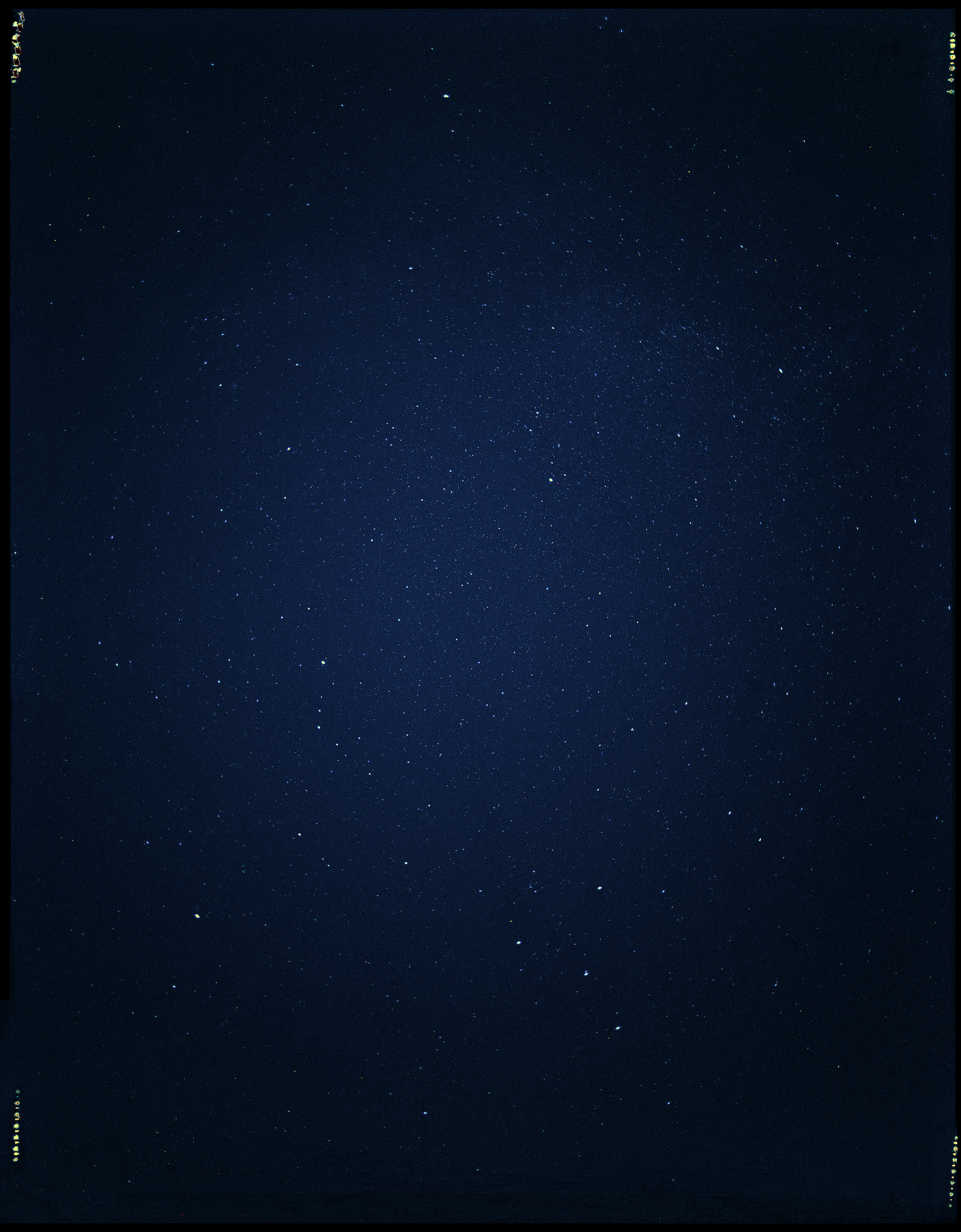
Image: 130 x 105 cm
Frame: 134 x 109 cm
It was in the night of Elea, an ancient Greek city near Naples, that Parmenides
first assumed that the Moon reflected the light of the Sun or that the Earth was a
sphere. By seeking out the logic at work in nature through his observations rather
than mythological accounts, he and other pre-Socratic philosophers helped to build
a new way of understanding the world.
This photograph of the sky over Elea was taken almost 2,500 years after Parme-
nides, by attaching a camera to a motor synchronised with the Earth's rotation,
which made it possible to follow the course of the stars and produce a perfectly
fixed image of the celestial vault.
Usually, no matter where in the world they are taken, photographs capture the
light of the Sun reflected on the world around us. However, in this photograph, the
light captured does not come from our Sun, but from thousands of distant suns.

Image: 130 x 105 cm
Frame: 134 x 109 cm
In the 6th century BC, the ancient city of Miletus stood on the shores of the Aegean Sea. Situated on the delta of the Meander River, equidistant from Ephesus to the north and Kos to the south, it was an important port city. Today, however, it lies some ten kilometers inland, as the alluvial deposits of the river have silted up the bay and gradually pushed it further away from the coast. Thales, the thinker often referred to as the first mathematician, geographer or astronomer, lived in Miletus, which overlooked the sea. It was here that his philosophy developed around the idea that «water is the principle of all things». By searching for the logic at work in nature using reason rather than mythological accounts, Thales opened the way to a new way of understanding the world. He and his successors, Anaximander and Anaximenes, laid the foundations for rational thought. Their philosophy of nature marked the beginning of a school of thought that flourished in the region, and that is considered in the West to be the origin of philosophy itself.
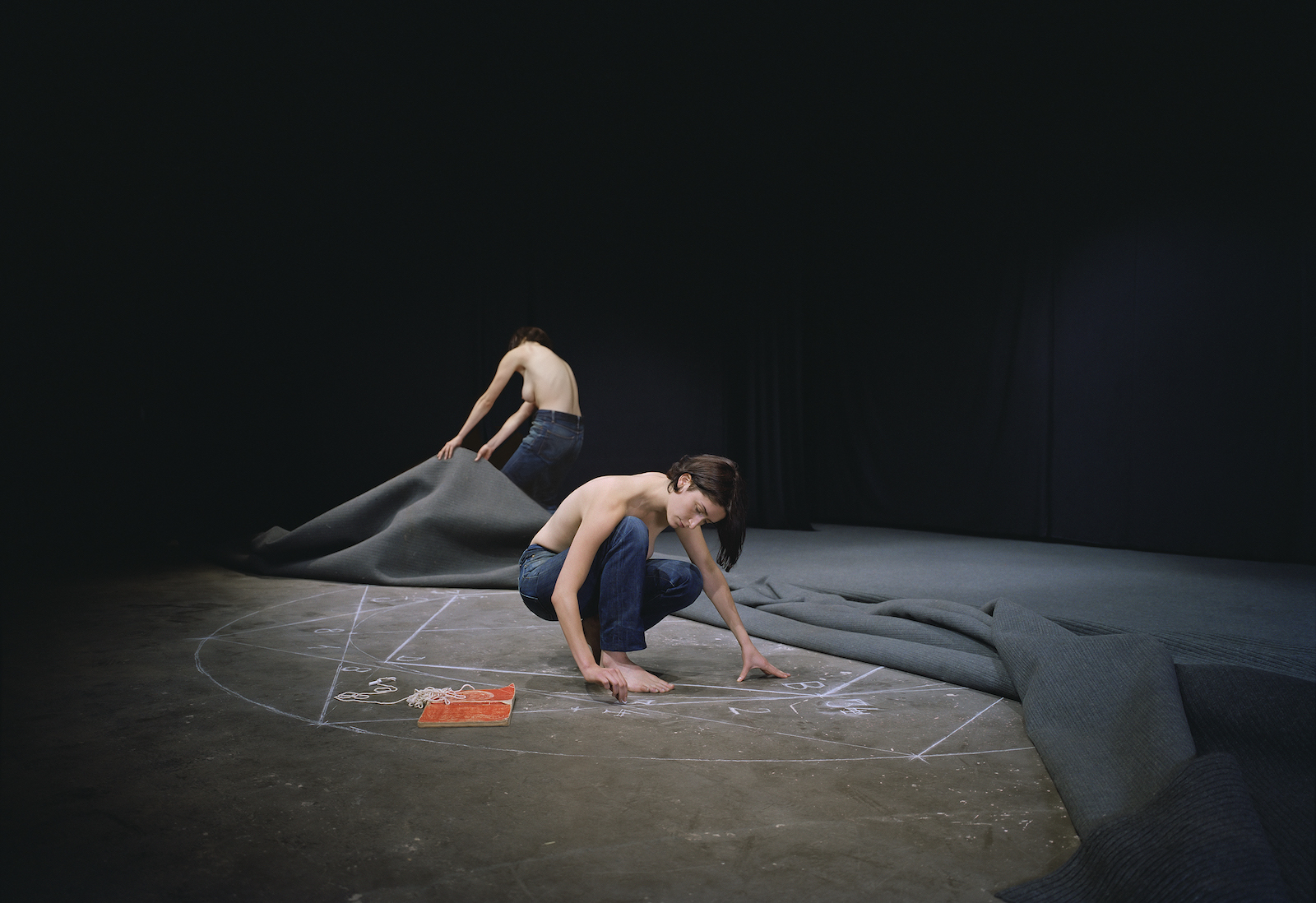
Image: 110 x 160 cm
Figure pentagonale is the title of a set of six photographs, seemingly similar, but each with subtle differences. Each image features the same woman in two different positions, thus juxtaposing two temporalities: one draws a pentacle on the floor with chalk, while the other manipulates the carpet covering a theatre stage. Calling on the register of magic, the book in the photo assumes that it can influence the course of time by modifying fortune through chance, and in particular the probability of winning at games.
This series proposes a reflection on causality, and in particular on the existence of chance and fortune. Each small particularity of each photograph reflects different causalities, which suggests in a Pascalian conception that chance does not exist. Only the causality that originates in the future - fortune - is a key to explaining the present event.
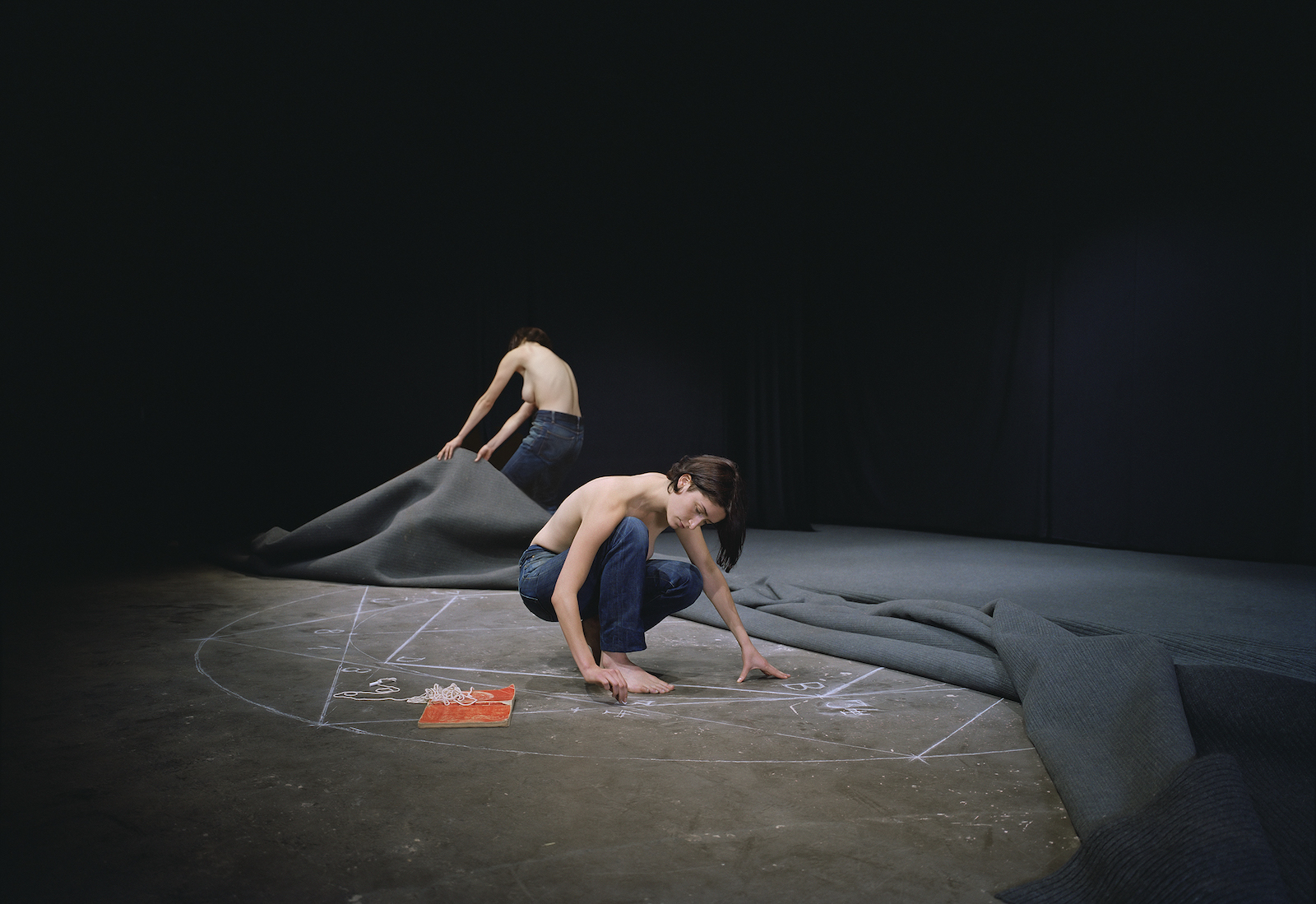
Image: 43 x 63 inches
Figure pentagonale is the title of a set of six photographs, seemingly similar, but each with subtle differences. Each image features the same woman in two different positions, thus juxtaposing two temporalities: one draws a pentacle on the floor with chalk, while the other manipulates the carpet covering a theatre stage. Calling on the register of magic, the book in the photo assumes that it can influence the course of time by modifying fortune through chance, and in particular the probability of winning at games.
This series proposes a reflection on causality, and in particular on the existence of chance and fortune. Each small particularity of each photograph reflects different causalities, which suggests in a Pascalian conception that chance does not exist. Only the causality that originates in the future - fortune - is a key to explaining the present event.
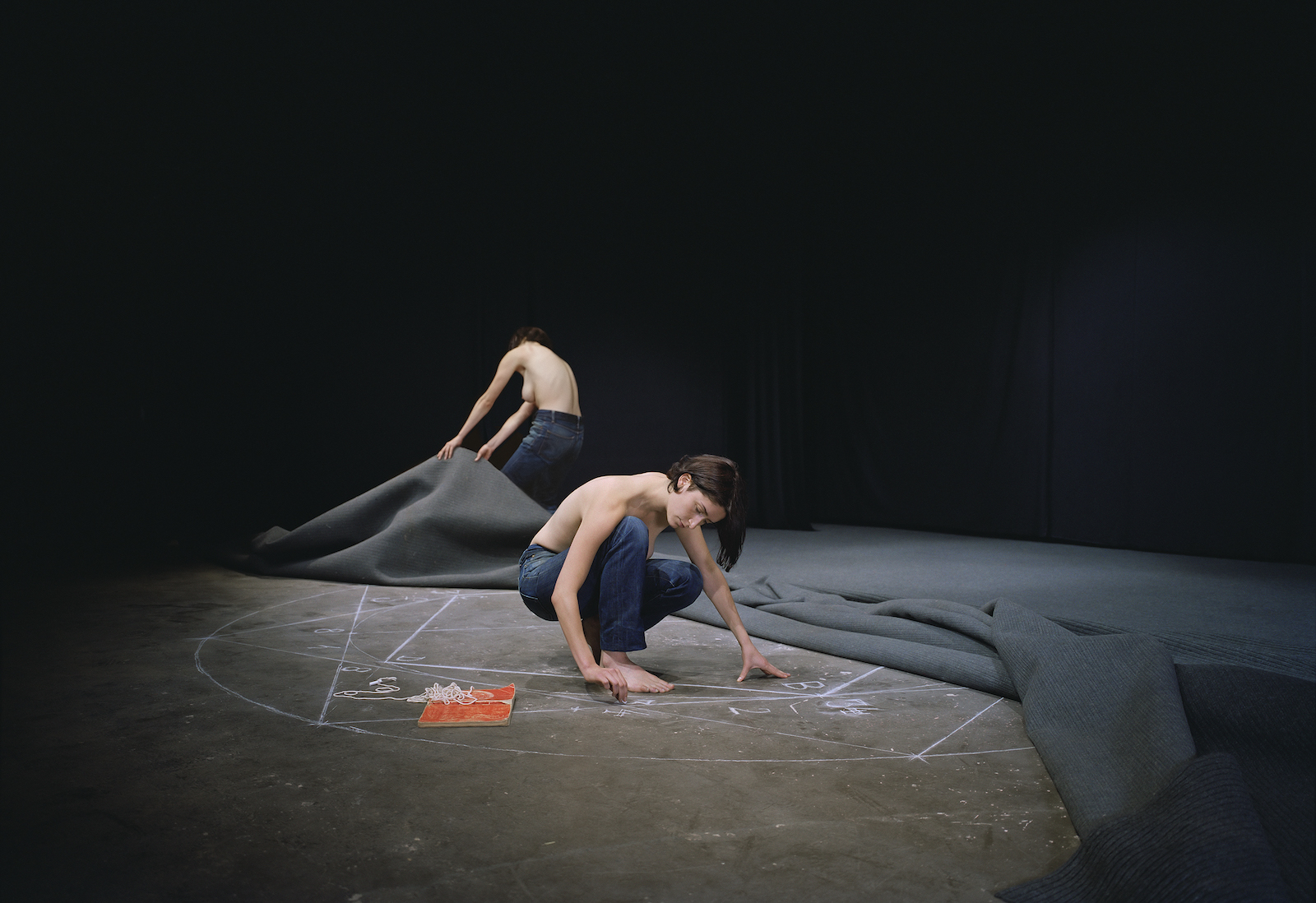
Image: 43 x 63 inches
Figure pentagonale is the title of a set of six photographs, seemingly similar, but each with subtle differences. Each image features the same woman in two different positions, thus juxtaposing two temporalities: one draws a pentacle on the floor with chalk, while the other manipulates the carpet covering a theatre stage. Calling on the register of magic, the book in the photo assumes that it can influence the course of time by modifying fortune through chance, and in particular the probability of winning at games.
This series proposes a reflection on causality, and in particular on the existence of chance and fortune. Each small particularity of each photograph reflects different causalities, which suggests in a Pascalian conception that chance does not exist. Only the causality that originates in the future - fortune - is a key to explaining the present event.
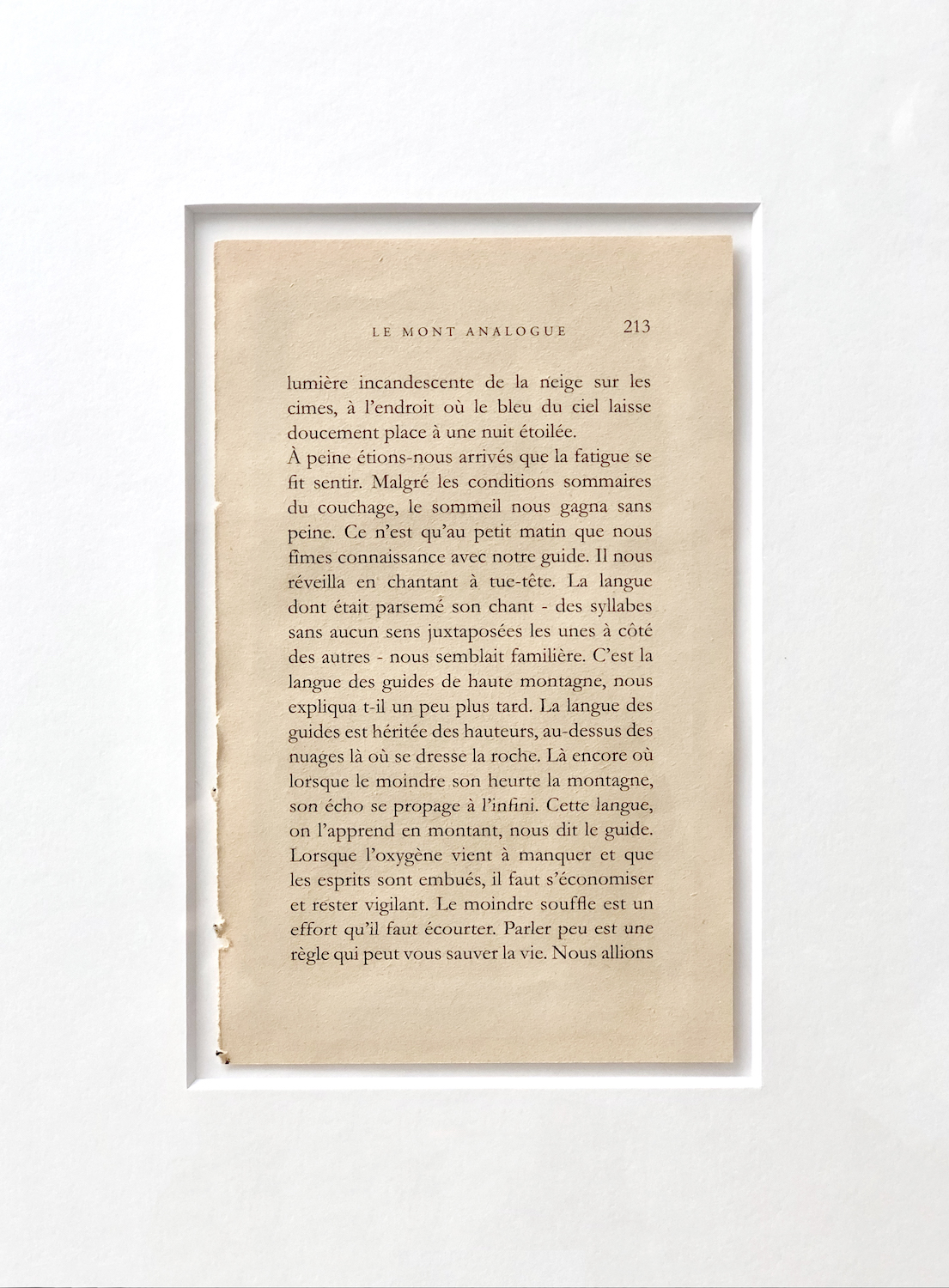
18,5 x 11 cm
Hypothétique page de la fin du cinquième chapitre du Mont Analogue de René Daumal is a page added to Daumal's unfinished novel as published by Gallimard in 1952. Daumal wrote the book between 1939 and 1944, knowing that he was dying of tuberculosis. This "novel of alpine, non-Euclidian, symbolically authentic adventures" is an account of an expedition that sets out to locate and climb a mythological mountain linking the earth and the sky. Daumal died leaving only a few notes for the work's final chapters.
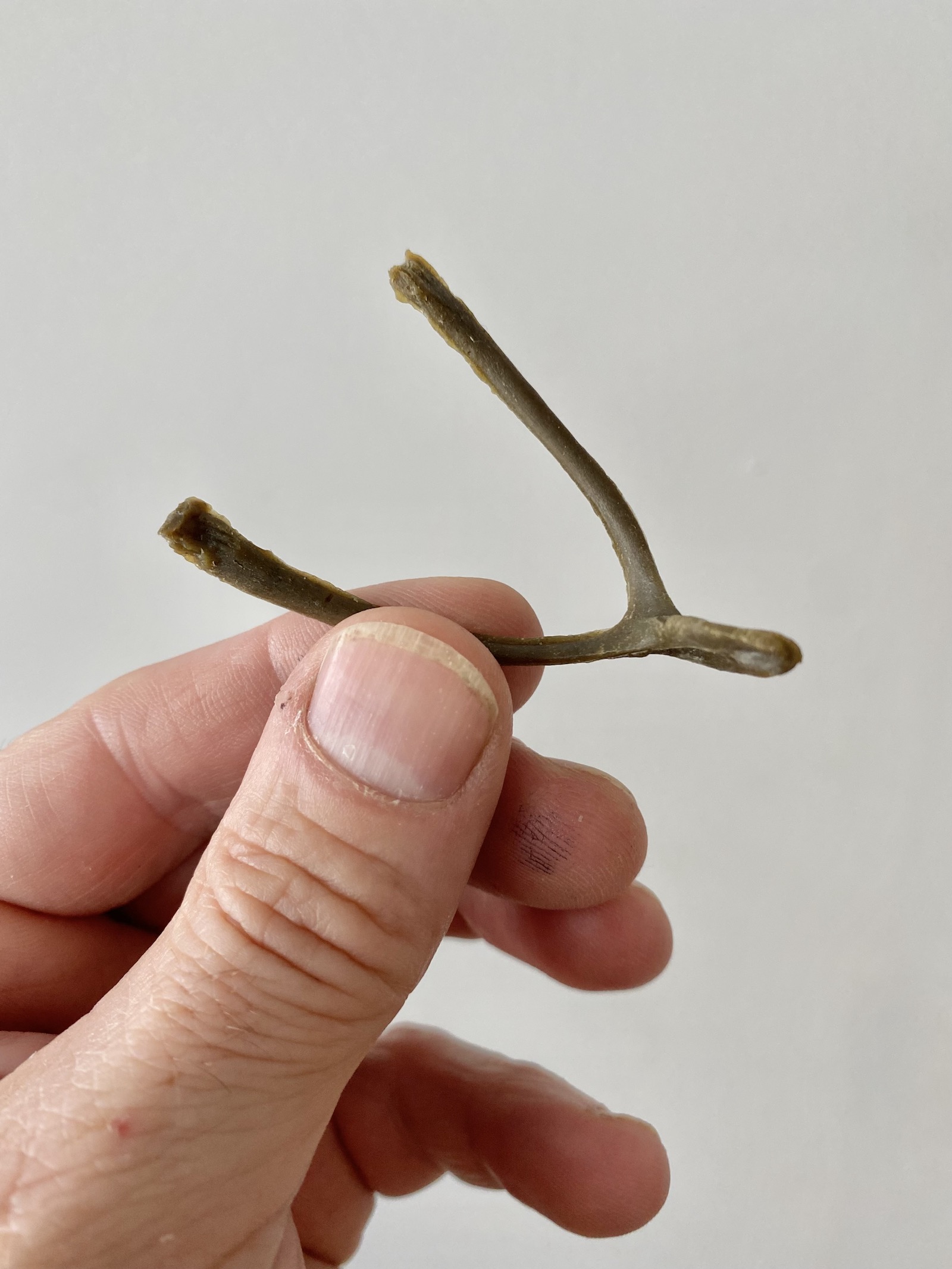
7 x 4 x 2 cm
Ed. 1/3
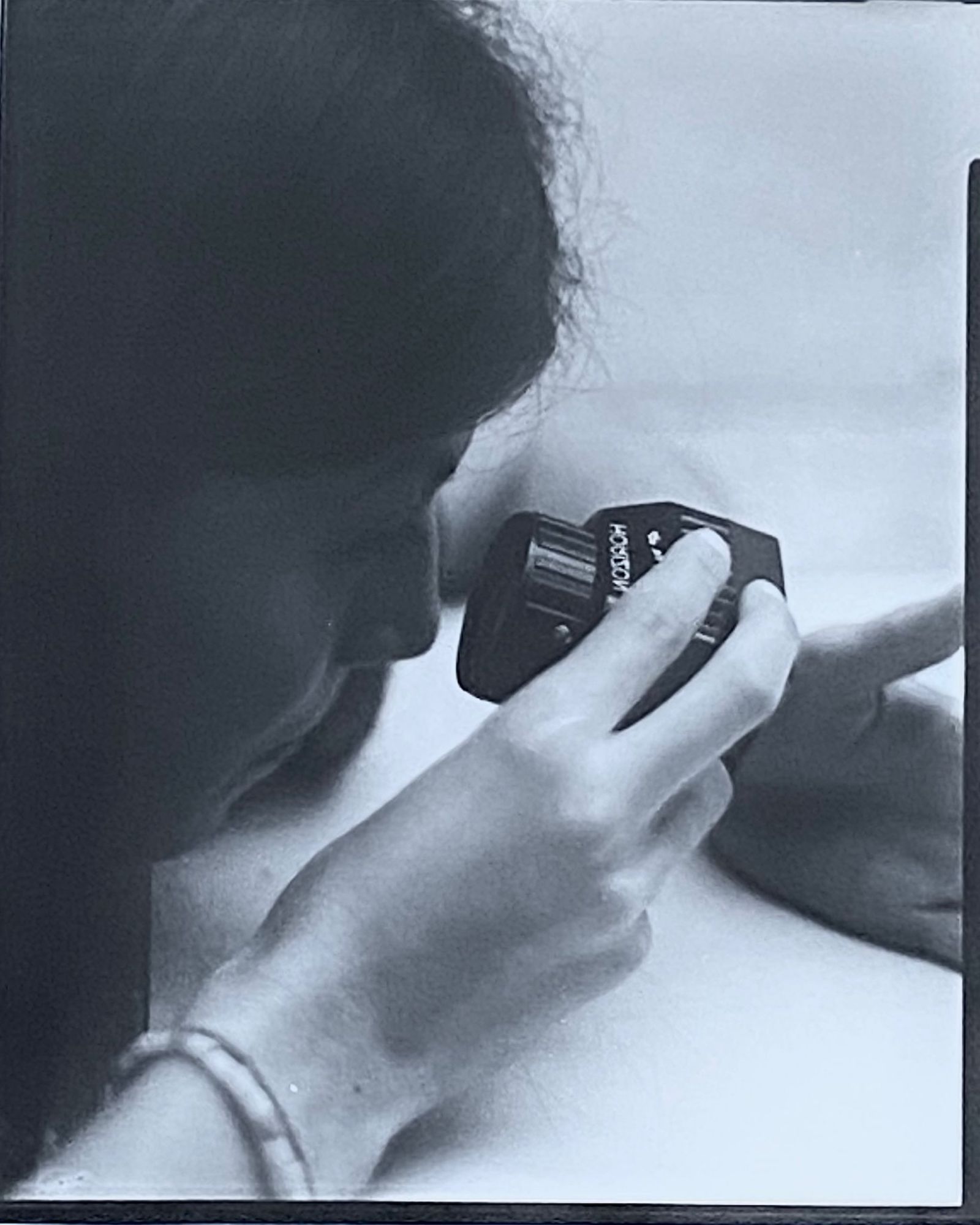
Image: 19 x 24 cm
Frame: 30 x 40 cm
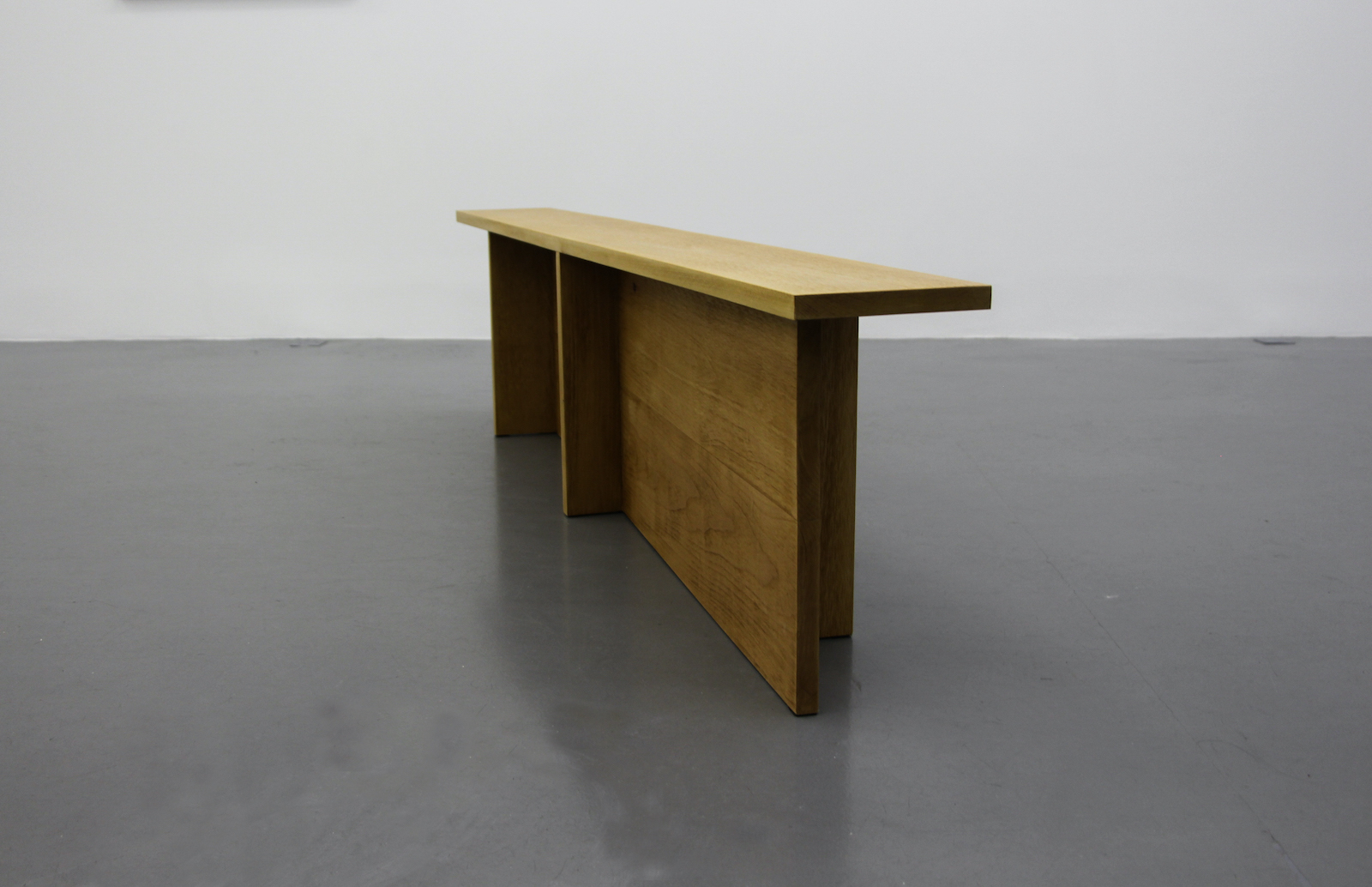
43 x 179 x 20.5 cm
Pour l'exposition anniversaire de la galerie, Laurent Montaron a réalisé un banc, inspiré d'un tabouret dit « chauffe-dos », qu'il avait produit plus tôt à partir d'une seule planche suite à une demande de son fils. Ici, il développe ce mobilier en utilisant cinq plans juxtaposés en hêtre en clin d'oeil aux cinq années d'existence de la galerie. Souvent dans son travail, l'artiste présente des objets qui sortent du strict cadre de l'art, de manière à ce qu'ils puissent se confondre avec des objets annexes peuplant les salles d'expositions. Ici on pourrait penser à un banc d'exposition qui « place » le spectateur et lui propose une posture pour regarder mais qui se trouve finalement être l'oeuvre elle-même.
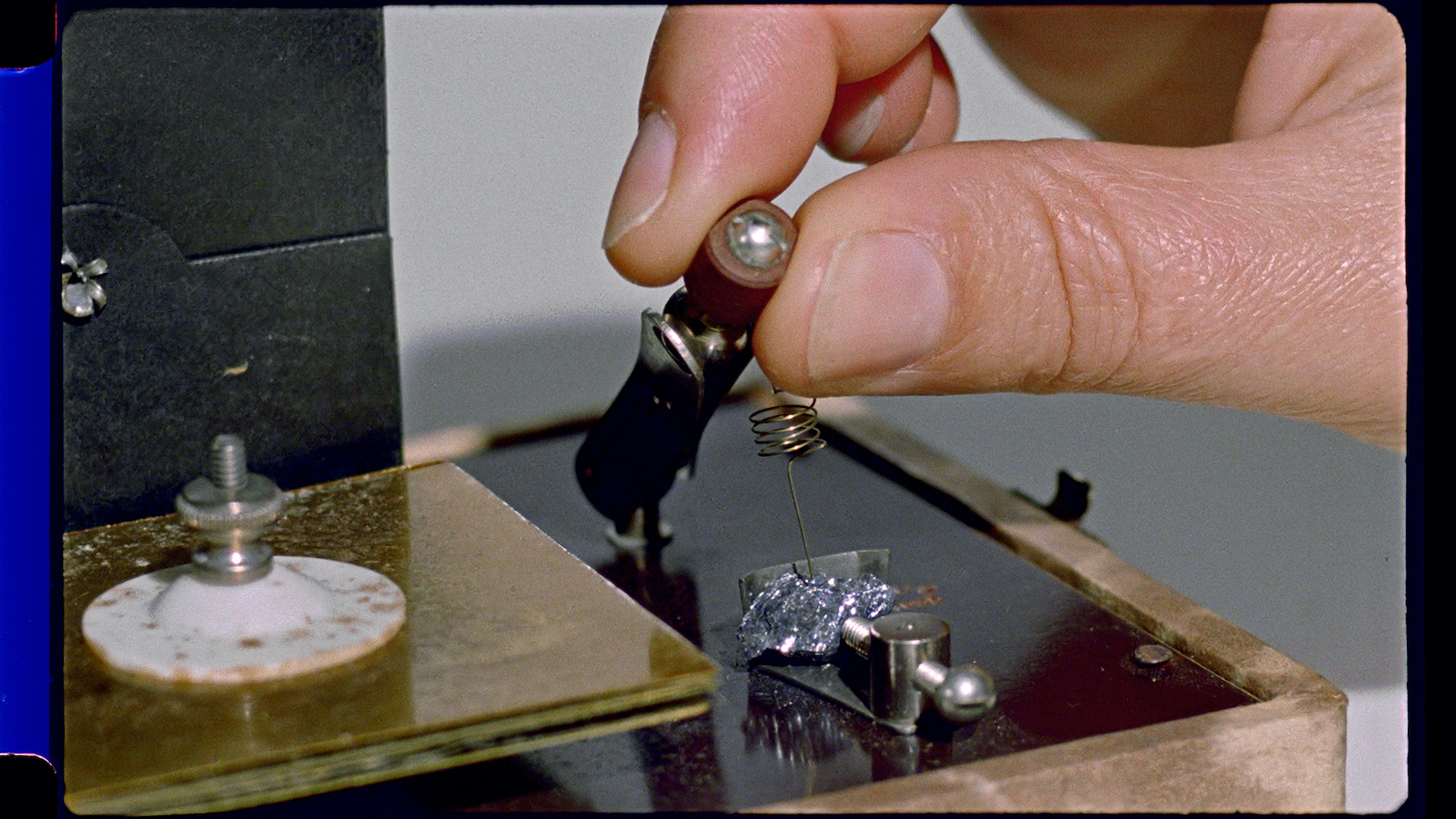
1'26"
Ed. 1/3
_
Editing : Laurent Montaron
Camera assistant : Lucas Léglise
Camera : Aaton XTR Prod
Film : 16mm Kodak Vision3 200T 7213
Laboratory : Film Factory, Paris
Telecine : Blackmagic Cintel Film Scanner
_
In this film, the artist films a galena set, a rudimentary form of radio receiver popular in the early radio era. The device was named for its most important component, a receiver made from lead ore. This metal, once considered an essential element in alchemical processes, is now commonly used in automobile and computer batteries. In the film, a hand can be seen trying to reach a radio signal, re-enacting a pivotal moment in media history where science and alchemy coexist and as Arthur C. Clarke points out "Any sufficiently advanced technology is indistinguishable from magic."

51 x 30 x 52 cm
The title of this piece is borrowed from the shofar, an ancient musical horn used for Jewish religious purposes. This instrument is blown on two different celebrations: Rosh Hashanah, the Jewish new year, and on Yom Kippur, the day of the atonement. If we instead focus on the material of these artworks, we can grasp another layer of meaning that refers to the junction of two opposing states connected by a medium. Indeed, the finite connotation of the term ?artwork? does not really apply to these horns as they are two wax casts. A cast represents a state in between a real object and a future object, an original and a replica. Montaron is interested in the liminal state inhabited by these fragile works that endows them to function as a reproduction tool, that, in the same way as a photographic negative does, steals the ?now? and ?where?- to borrow Benjamin?s words- of the object being cast.

14 x 9 x 4 cm
Immediacy is a work consisting of a portable cassette tape recorder that records ambient sounds onto an endless cassette, erasing what has just been recorded onto the tape as it goes along.
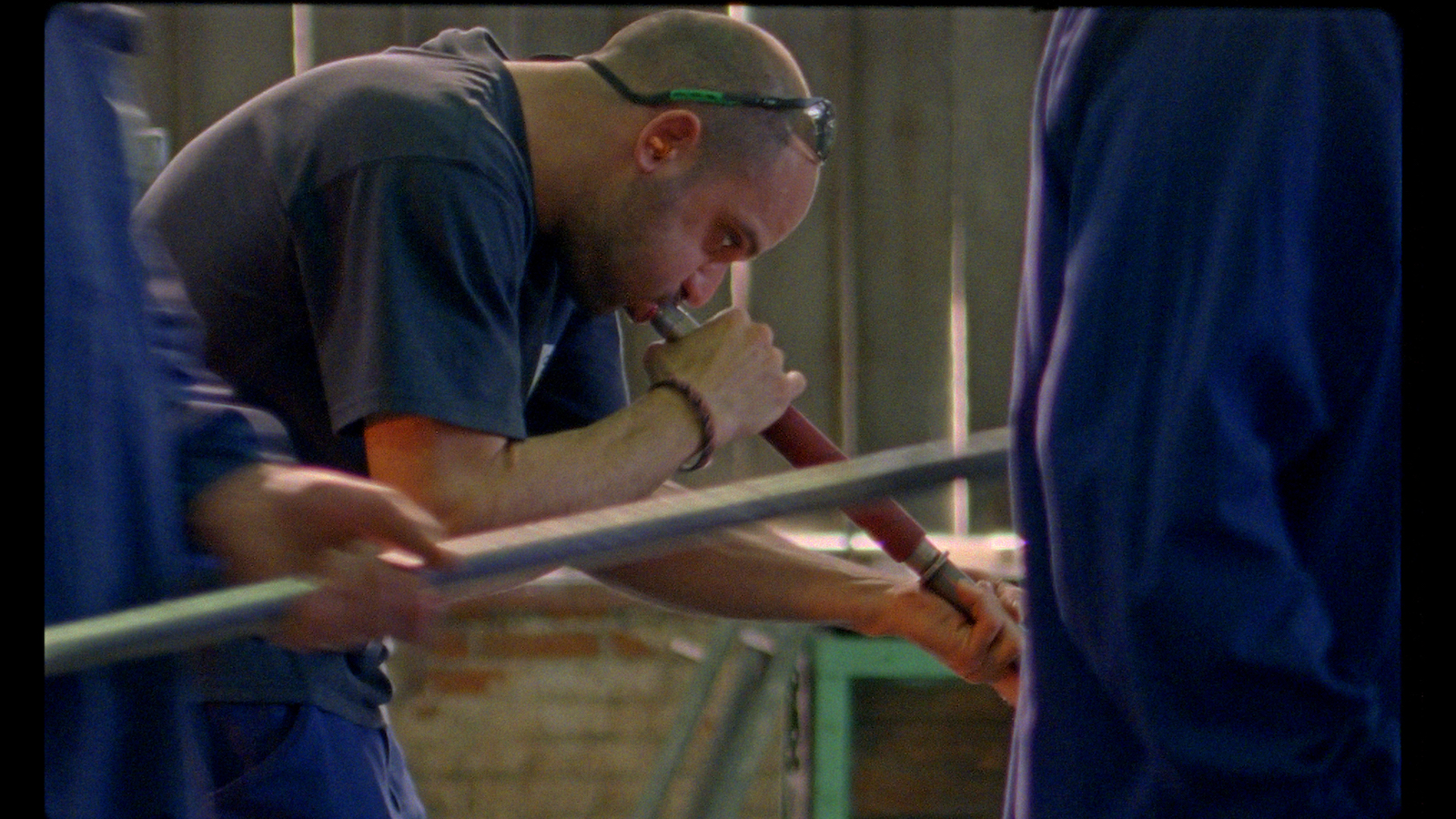
19'01''
Camera Assistant : Lucas Léglise
Script : Mana Kikuta
Perchman : Clémence Joly
Set up : Laurent Montaron
Music : Vincent Guédon, Laurent Montaron
Camera Aaton XTR Prod
Optiques : Angénieux
Film 16 mm Kodak Vision3 500 T 5219
Laboratory : Silverway, Paris
Telecinéma : Blackmagic Cintel Film Scanner
With the support of Verrerie Saint-Just, Saint-Gobain Glass France S.A. and CCA,Tel Aviv.
https://vimeo.com/275388259 (password : macluhan)
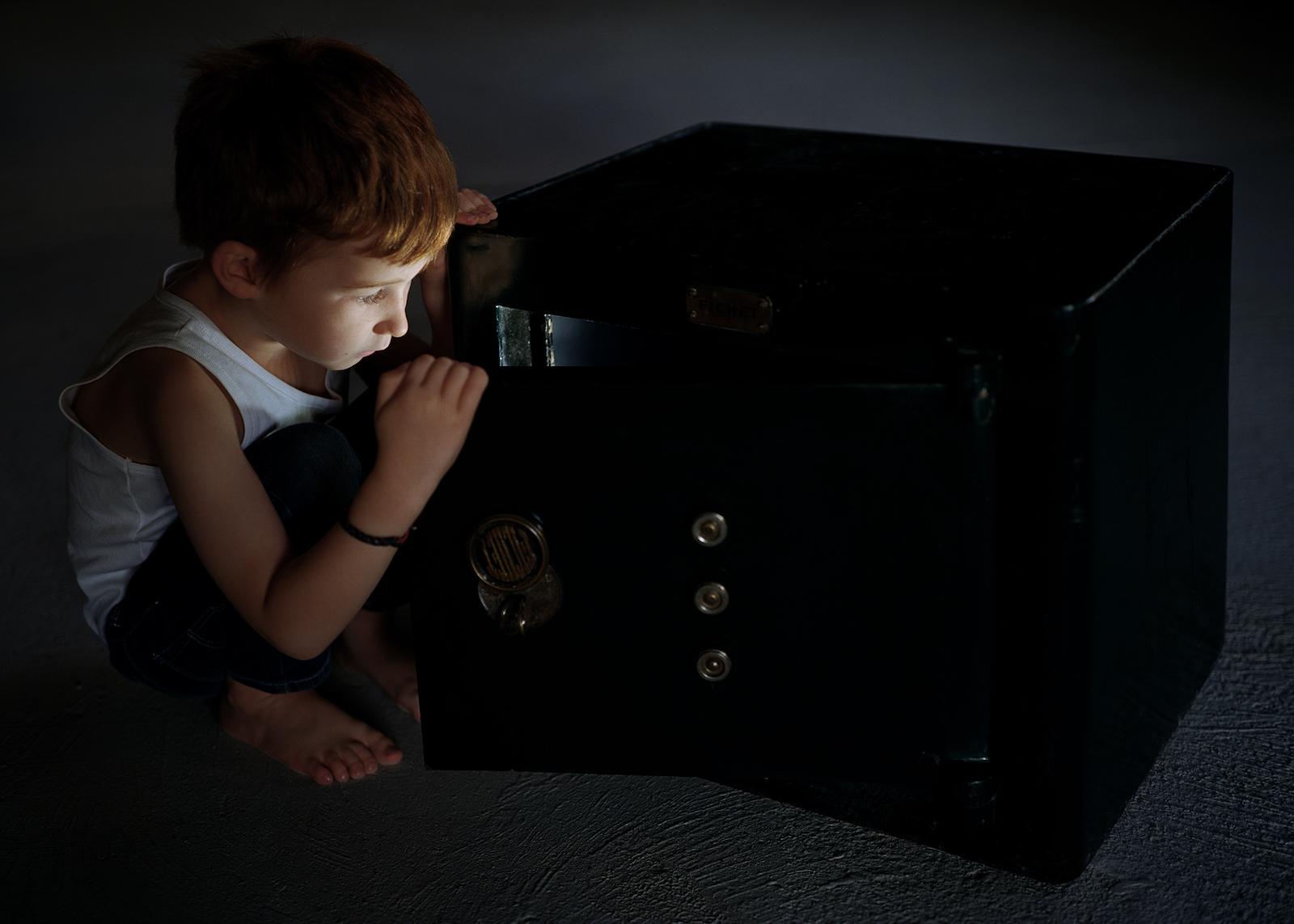
Image: 50 x 70 cm
Le monde forclos is a photograph in which appears the face of a child illuminated by a light coming out of a safe. The chiaroscuro lets us think that the light he discovers in the doorway is that of the day. The title invites us to consider the image as an inversion of the world, the term "forclos" meaning "locked outside".
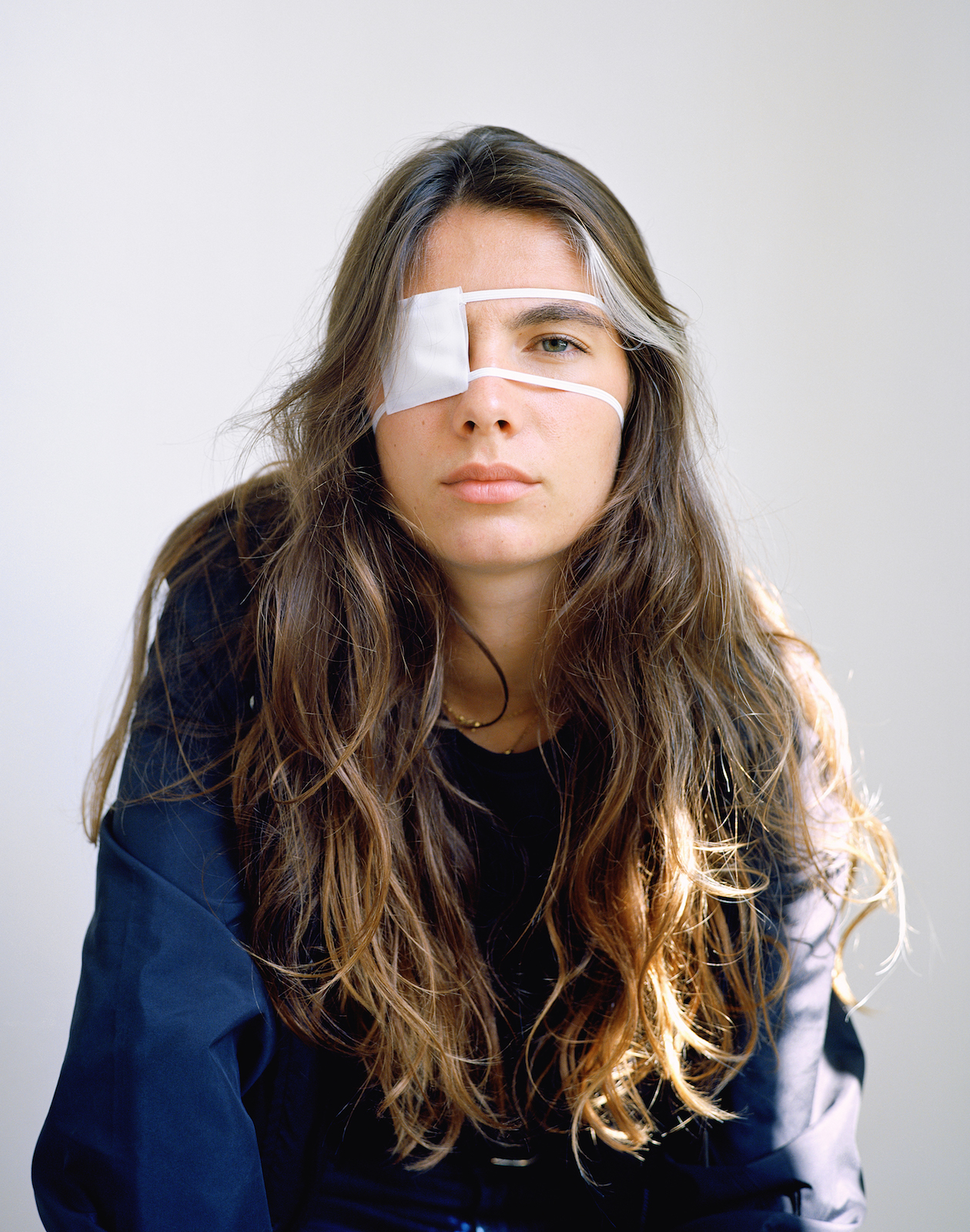
Color photograph
Image: 80 x 63 cm
Frame: 83,5 x 66,5 cm
Human being perceives relief and locates himself in space thanks to the coordination of his two eyes. This simple assertion is at stake in the Télé-vision series, which is conceived as a representation of seeing in the form of a photographic portrait. In the manner of a stereoscopic vision, in which the combination of two images is essential to the apprehension of space and volume. Each photograph embodies the point of view of a single eye, both for the viewer and the model. The entire series thus proposes four similar but unique portraits, presented in pairs, in the image of the gaze that is cast upon them. By placing the viewer in front of the decomposition of the gaze, the series underlines the way in which the omnipresence of images modifies our relationship to the world. The transmission of sense experience through words is slowly replaced by a truncated two-dimensional world constructed by images.

Color photograph
Image: 80 x 63 cm
Frame: 83,5 x 66,5 cm
Human being perceives relief and locates himself in space thanks to the coordination of his two eyes. This simple assertion is at stake in the Télé-vision series, which is conceived as a representation of seeing in the form of a photographic portrait. In the manner of a stereoscopic vision, in which the combination of two images is essential to the apprehension of space and volume. Each photograph embodies the point of view of a single eye, both for the viewer and the model. The entire series thus proposes four similar but unique portraits, presented in pairs, in the image of the gaze that is cast upon them. By placing the viewer in front of the decomposition of the gaze, the series underlines the way in which the omnipresence of images modifies our relationship to the world. The transmission of sense experience through words is slowly replaced by a truncated two-dimensional world constructed by images.
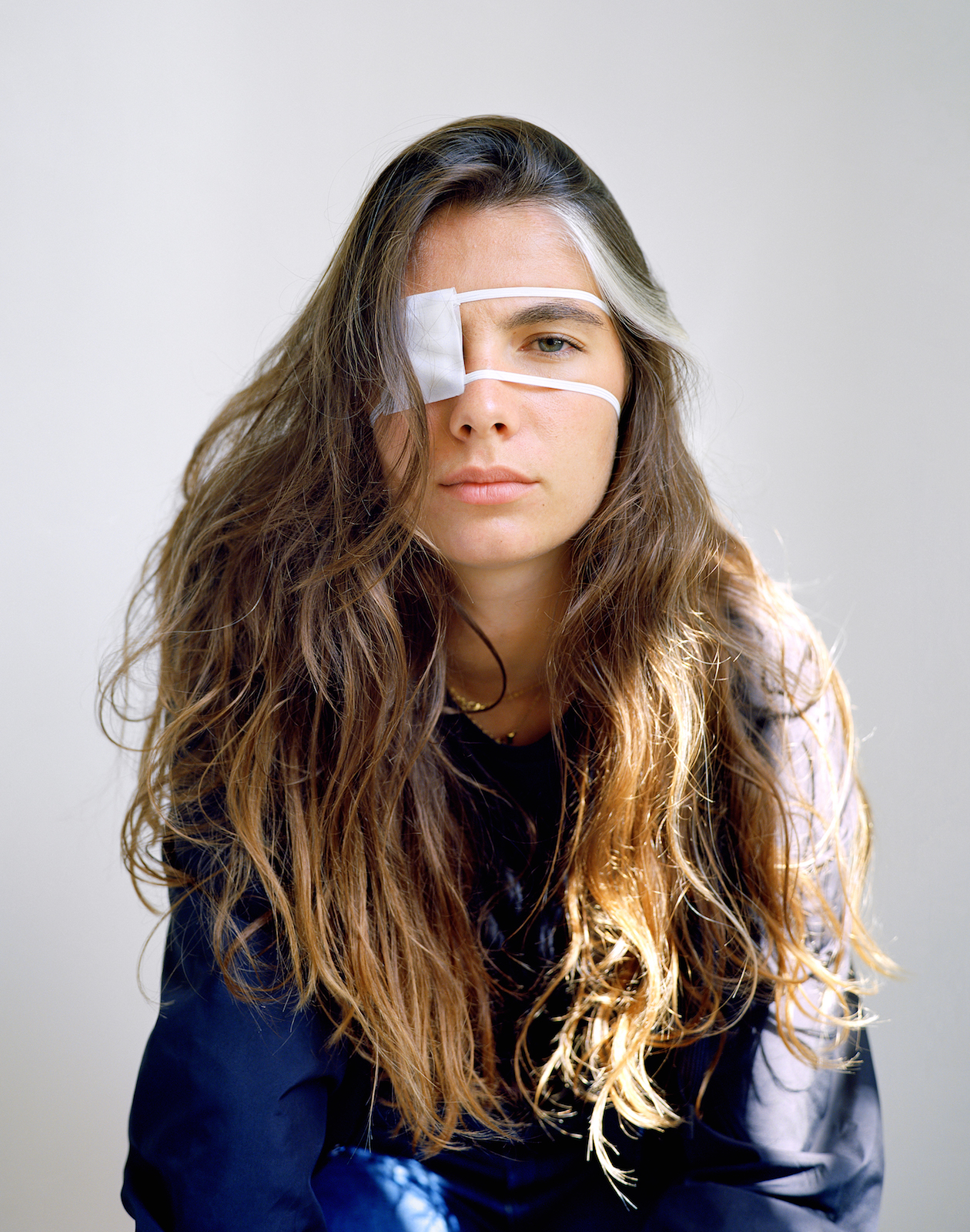
Color photograph
Image: 31,5 x 24, 8 inc
Frame: 32,8 x 26 inch
Human being perceives relief and locates himself in space thanks to the coordination of his two eyes. This simple assertion is at stake in the Télé-vision series, which is conceived as a representation of seeing in the form of a photographic portrait. In the manner of a stereoscopic vision, in which the combination of two images is essential to the apprehension of space and volume. Each photograph embodies the point of view of a single eye, both for the viewer and the model. The entire series thus proposes four similar but unique portraits, presented in pairs, in the image of the gaze that is cast upon them. By placing the viewer in front of the decomposition of the gaze, the series underlines the way in which the omnipresence of images modifies our relationship to the world. The transmission of sensitive experience through words is slowly replaced by a truncated two-dimensional world constructed by images.
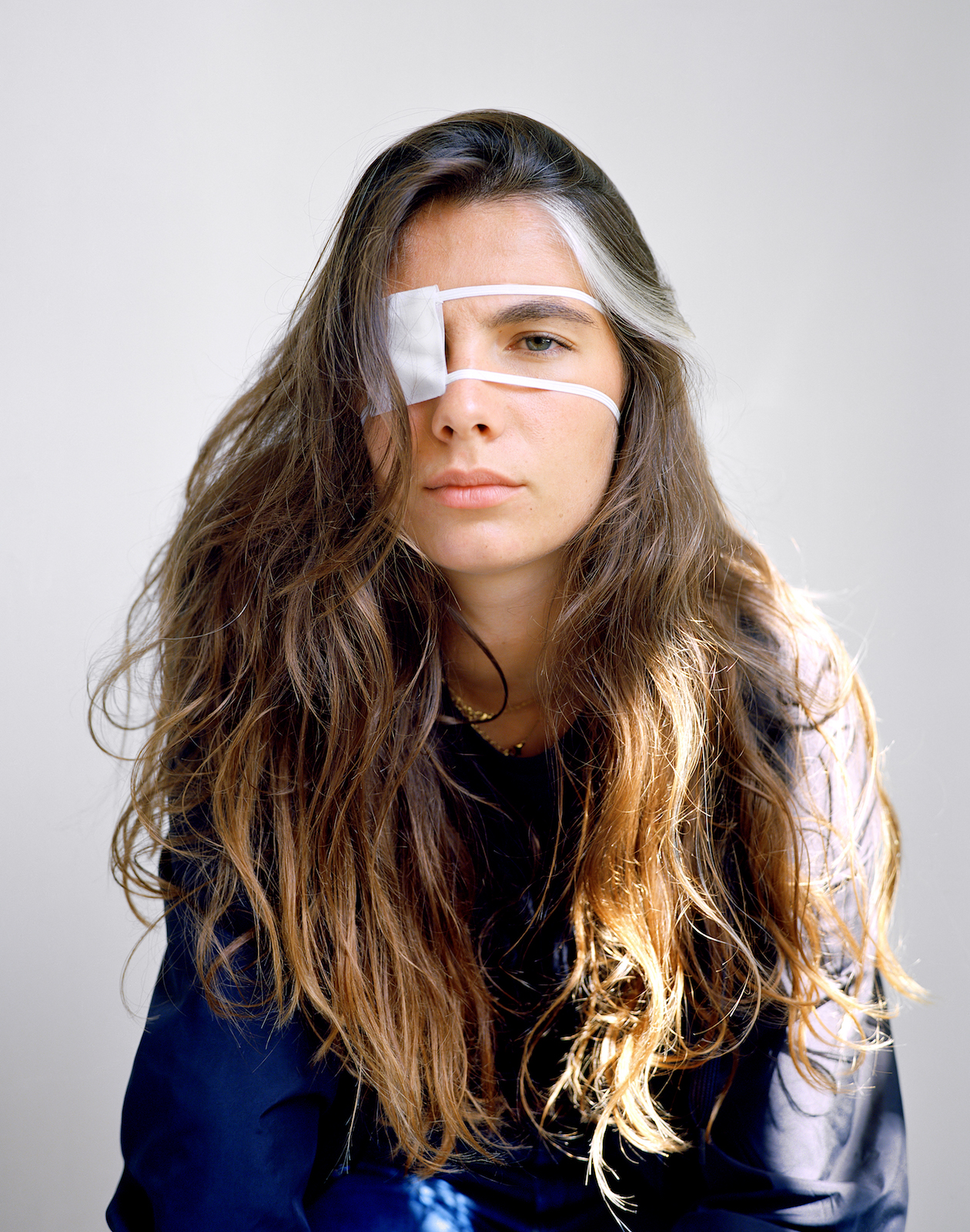
color photograph
Image: 31,5 x 24, 8 inc
Frame: 32,8 x 26 inch
Human being perceives relief and locates himself in space thanks to the coordination of his two eyes. This simple assertion is at stake in the Télé-vision series, which is conceived as a representation of seeing in the form of a photographic portrait. In the manner of a stereoscopic vision, in which the combination of two images is essential to the apprehension of space and volume. Each photograph embodies the point of view of a single eye, both for the viewer and the model. The entire series thus proposes four similar but unique portraits, presented in pairs, in the image of the gaze that is cast upon them. By placing the viewer in front of the decomposition of the gaze, the series underlines the way in which the omnipresence of images modifies our relationship to the world. The transmission of sensitive experience through words is slowly replaced by a truncated two-dimensional world constructed by images.
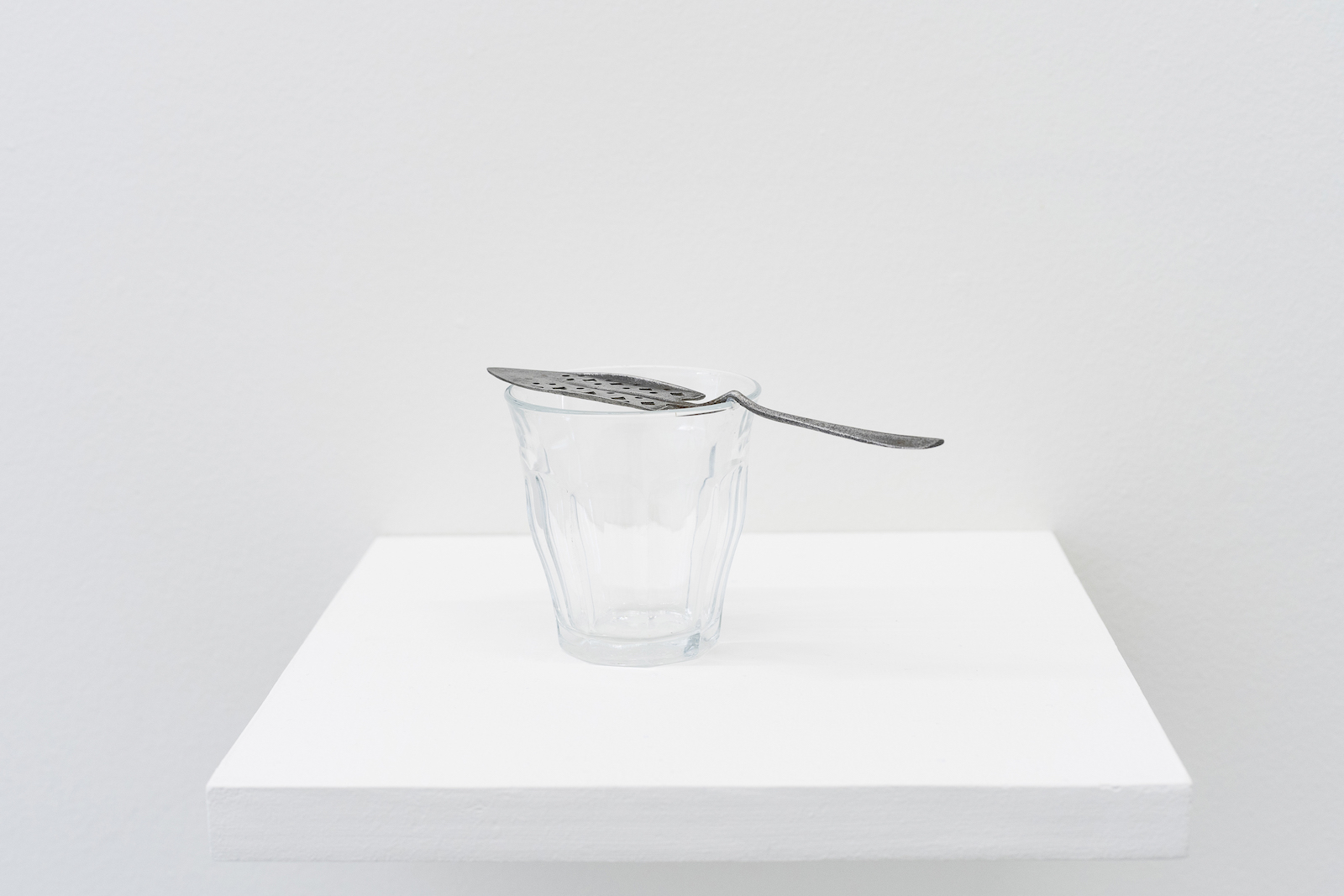

Image: 4 x 5 inch
Ed. 3/10
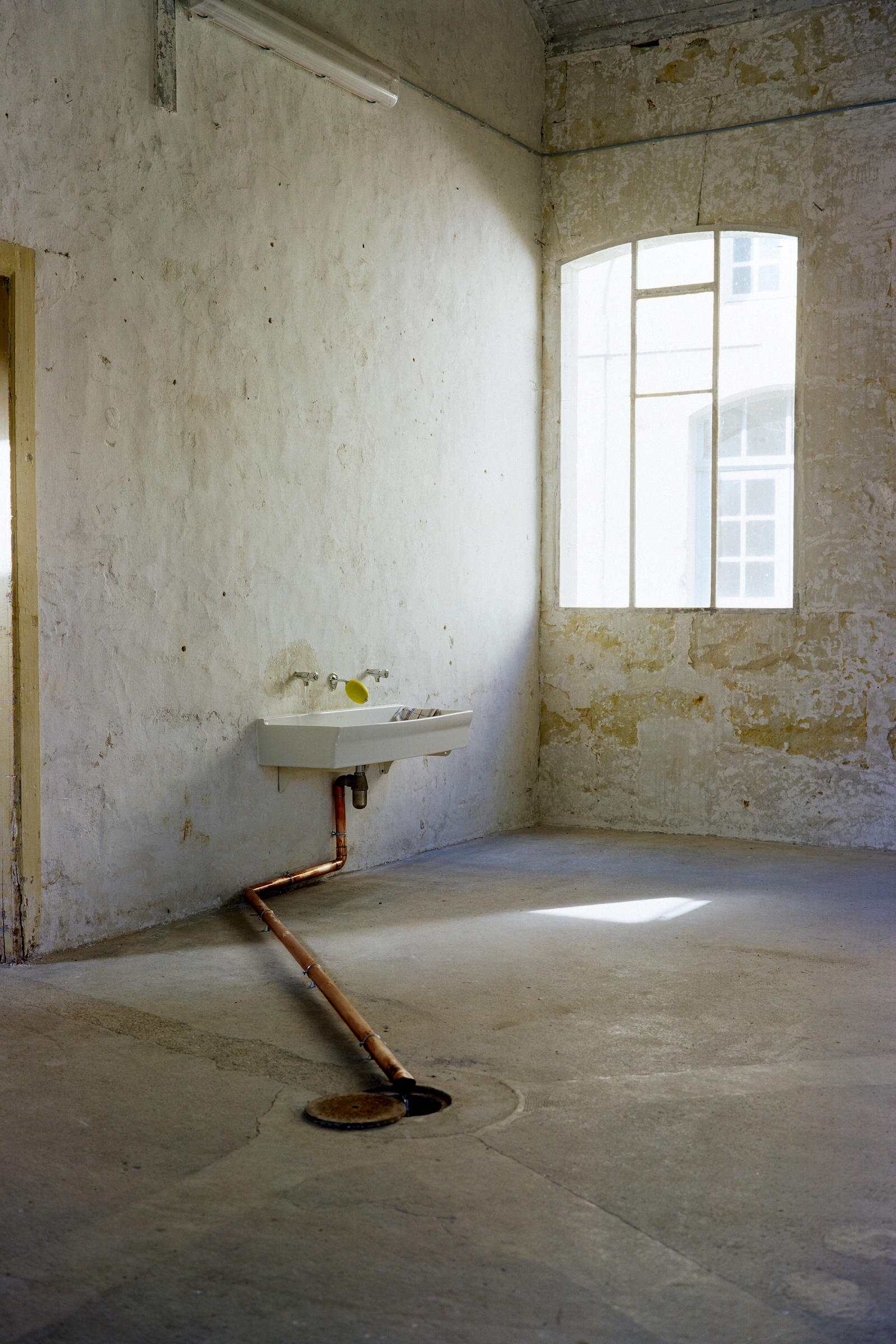
Sink : 39,4 x 17,7 inch
"[...] So we see that, when the child learns to wash his hands, whashing is not the purpose, because he repeats the act several times, even when her hands are clean, and continues, as long as the need for tha activity is satisfied. His interest is all inside; he acts and builds himself without leaving any outside trace. "
Maria Montessori, L'autoeducazione nelle scuele elementari (Milan, Garzanti, 1992)
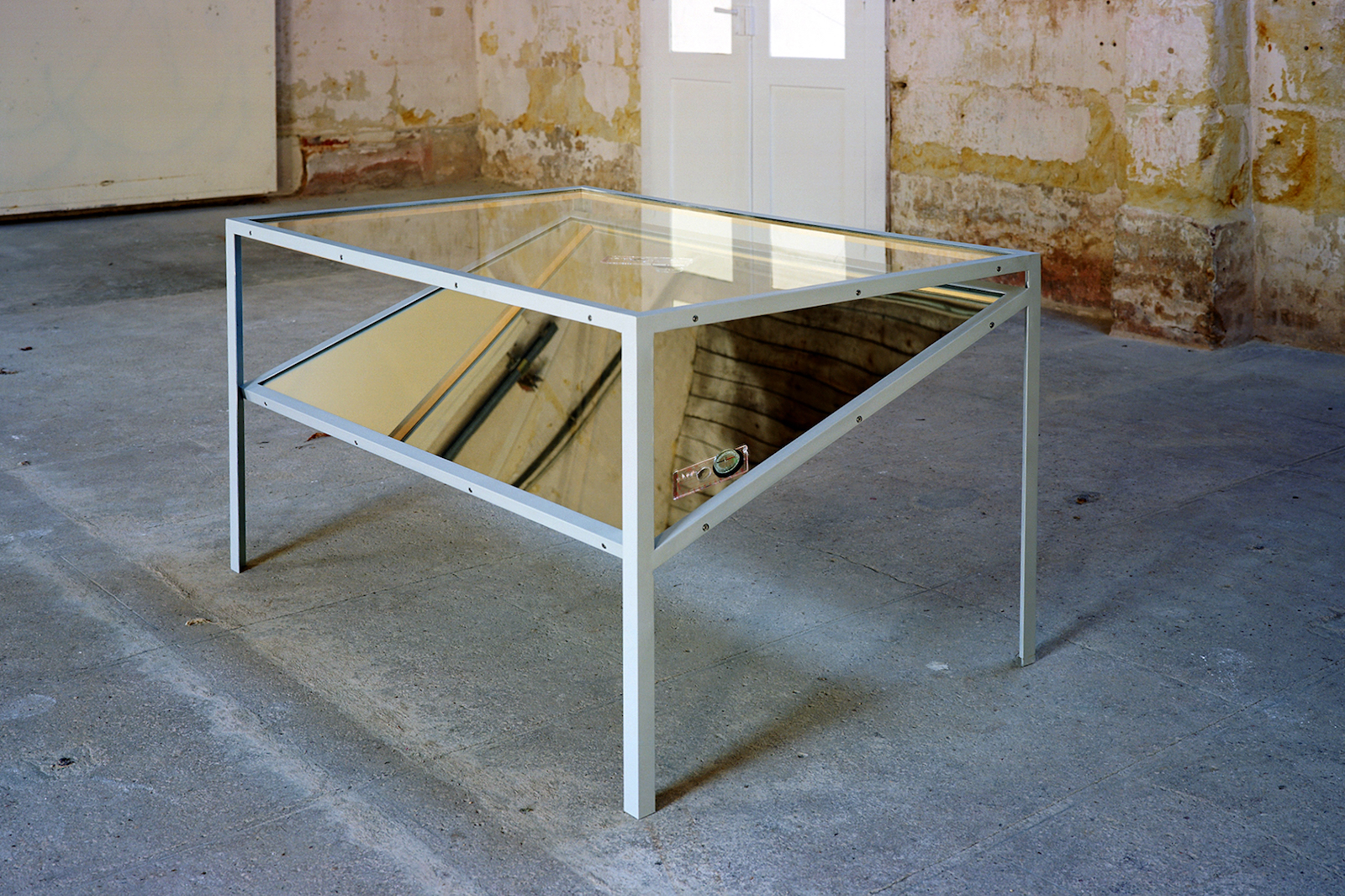
47,6 x 32,2 x 26,3 inch
Compass Experiment Table réplique la table ayant servi à la réalisation d'une série d'expériences menées à l'institut de recherche de Stanford en Californie pendant cinq semaines en 1972 avec Uri Geller. Personnage médiatique et controversé, habitué des plateaux de télévision dans les années 1980-90, et considéré par ses détracteurs comme un simple prestidigitateur, il s'est livré à plusieurs reprises à des expériences de télékinésie filmées ou retransmises à la télévision.
Avec le développement de l'information et la retransmission en direct, la perspective d'un progrès technologique qui permettrait d'abolir le temps et les distances est devenue un principe familier. Les expériences radio ou télé-diffusées de Geller tentaient de dépasser le principe d'une communication unilatérale pour rendre au receveur sa part active d'interlocuteur. Ces expériences de communication au travers des ondes étaient un révélateur de la part manquante d'une réciprocité révolue avec un interlocuteur devenu uniquement spectateur.
Lors de l'expérience dite de la boussole, Geller devait réussir à déplacer l'aiguille magnétisée d'une boussole placée sur une table. Sous celle-ci, un miroir permettait d'isoler chaque angle de vue pour la caméra qui documentait l'expérience. Uri Geller ne devait toucher ni la boussole ni la table. Après plusieurs essais infructueux, il put déplacer l'aiguille de quelques degrés à trois reprises, lentement et avec difficulté. Il suggéra ensuite une autre tentative en demandant aux personnes présentes de former un cercle autour de lui et cette fois le mouvement de l'aiguille augmenta perceptiblement.
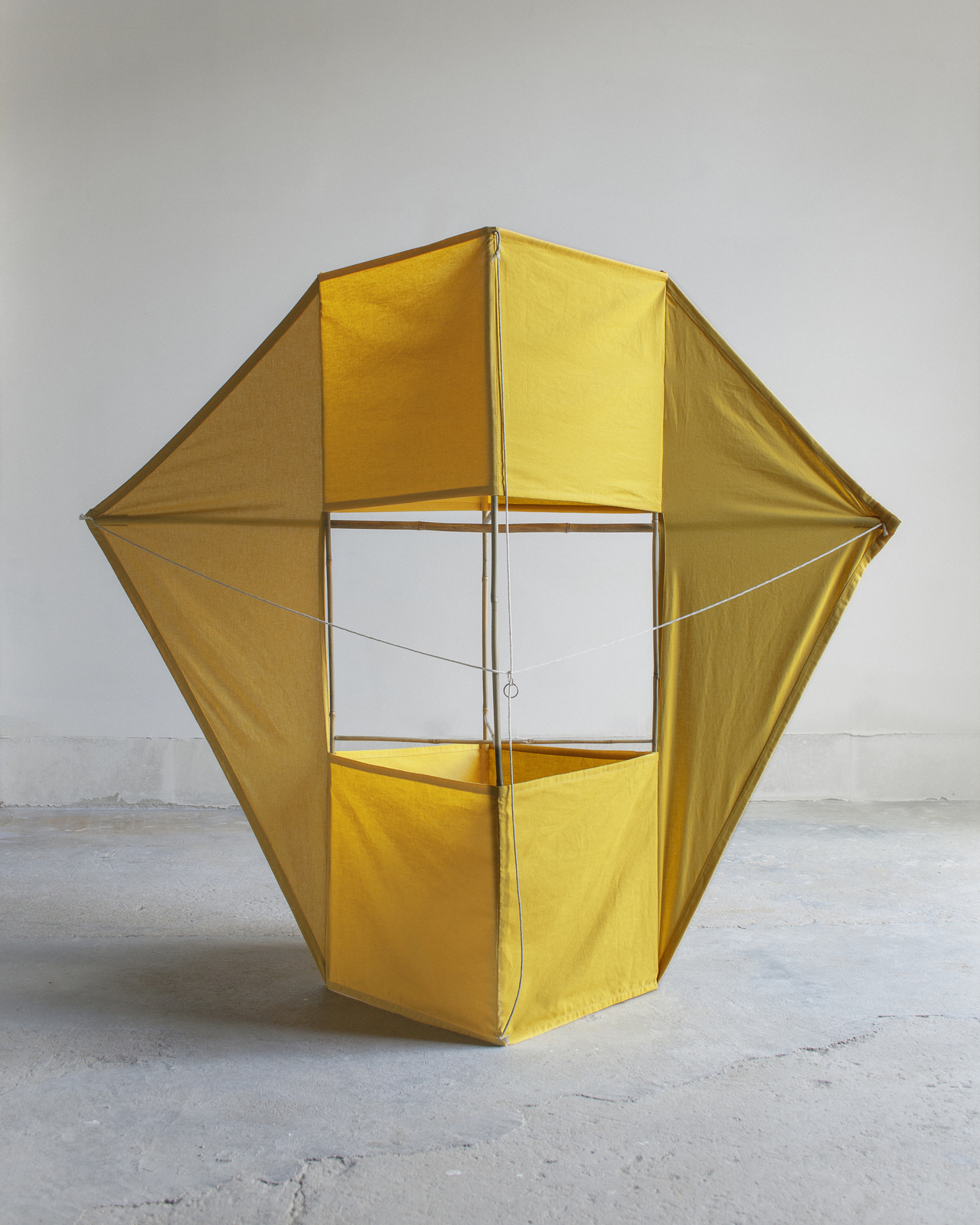
140 x 120 x 55 cm
Cette œuvre est une réplique d’un cerf-volant porte antenne, l’un des tout premiers dispositifs permettant la réception d’ondes radioélectriques de basses et moyennes fréquences via l’élévation d’une antenne radioélectrique.
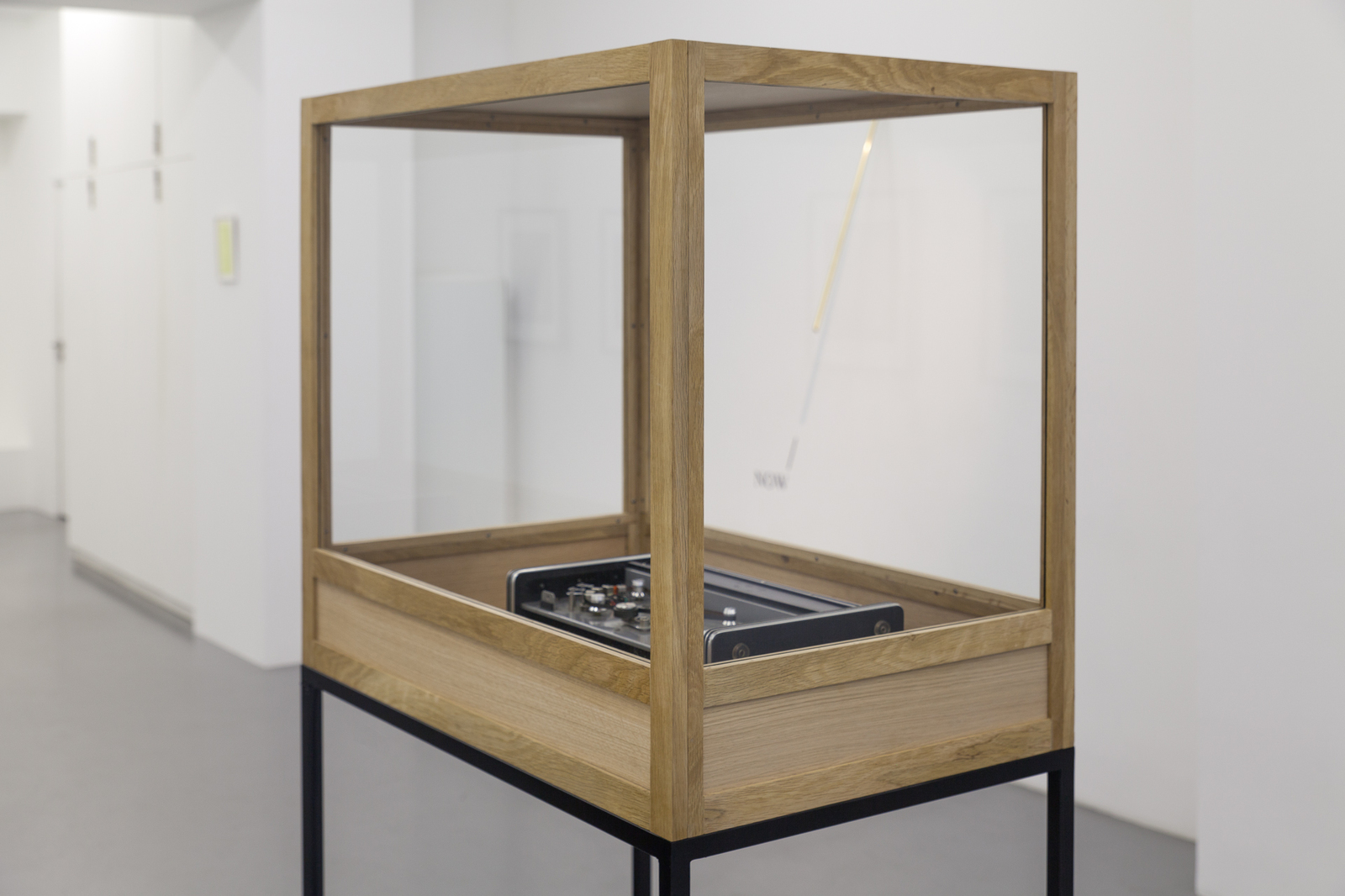
184 x 61 x 95 cm
Evans is a tape delay unit placed within a display case. The viewer cannot hear the recorded sounds coming from the tape, an endlessly repeated loop of the surrounding noises. A piece of adhesive tape on the erasing head prevents the sound from disappearing and continues to build on itself like an infinite memory process.
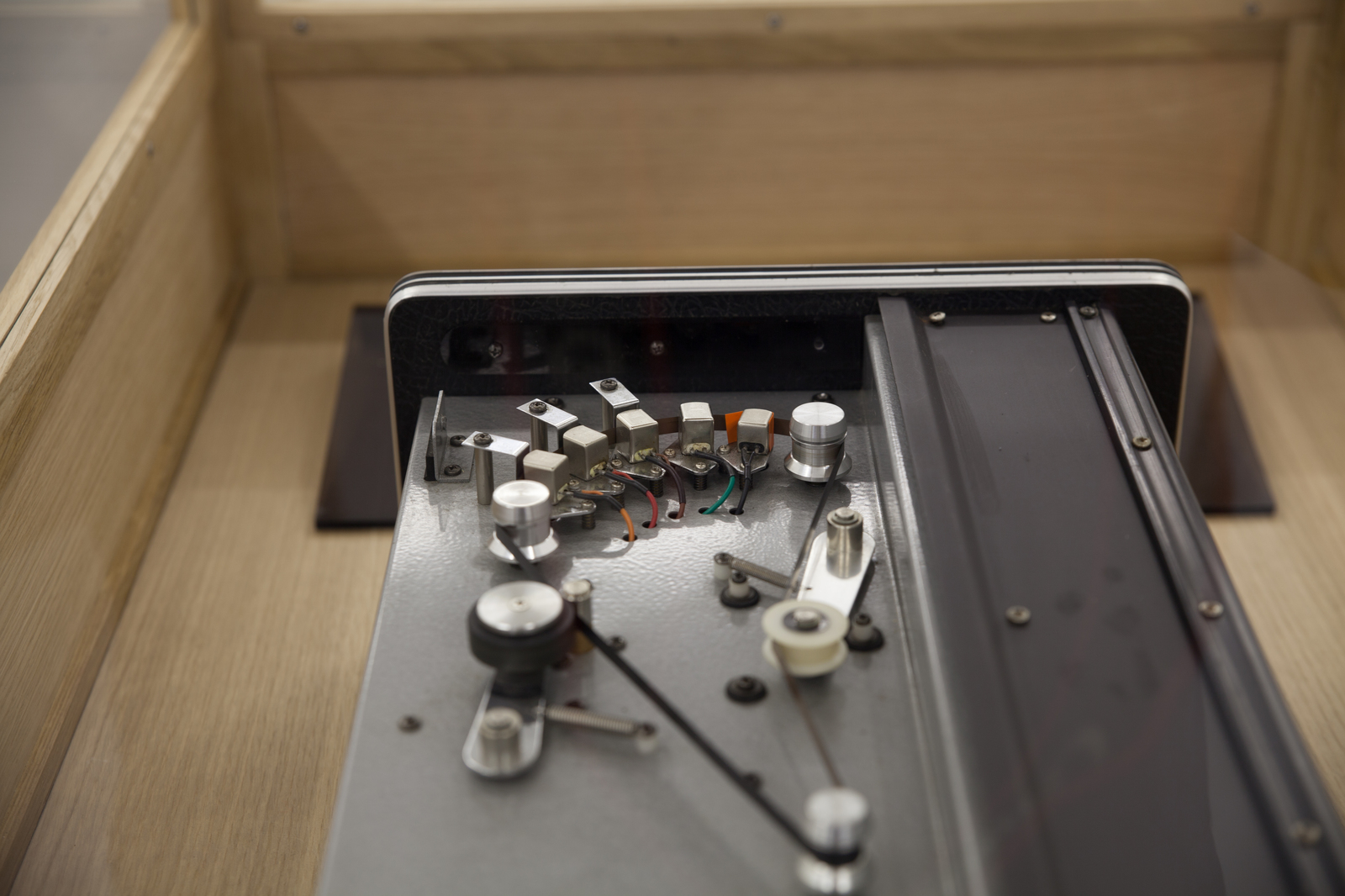
184 x 61 x 95 cm
Evans is a tape delay unit placed within a display case. The viewer cannot hear the recorded sounds coming from the tape, an endlessly repeated loop of the surrounding noises. A piece of adhesive tape on the erasing head prevents the sound from disappearing and continues to build on itself like an infinite memory process.
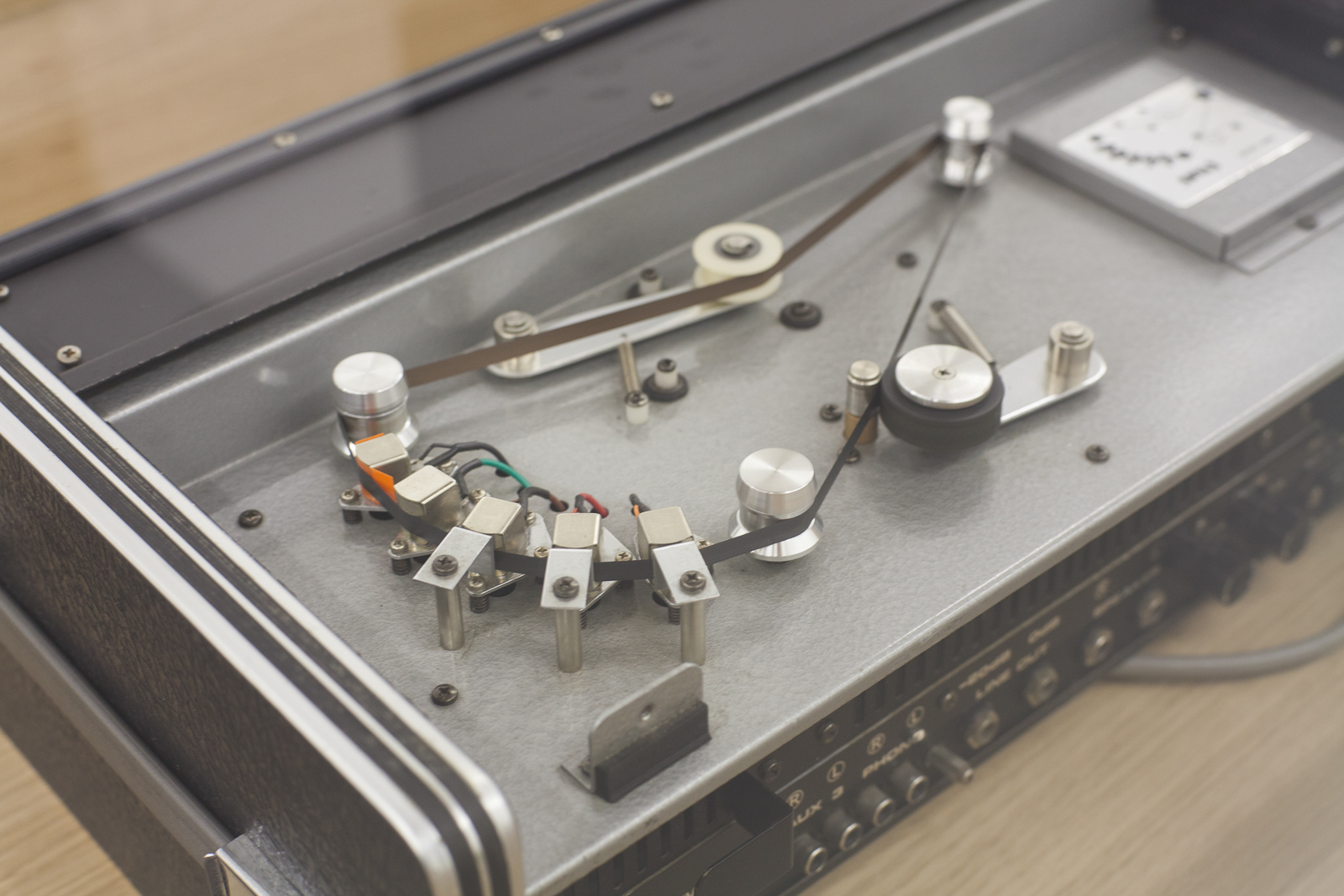
184 x 61 x 95 cm
Evans is a tape delay unit placed within a display case. The viewer cannot hear the recorded sounds coming from the tape, an endlessly repeated loop of the surrounding noises. A piece of adhesive tape on the erasing head prevents the sound from disappearing and continues to build on itself like an infinite memory process.

Image: 55x 36 5/8 inches
Blue Beckett is a raw scan of a negative. The picture was taken during the building of a model of Samuel Beckett's house in Ussy-sur-Marne, in the countryside outside of Paris.
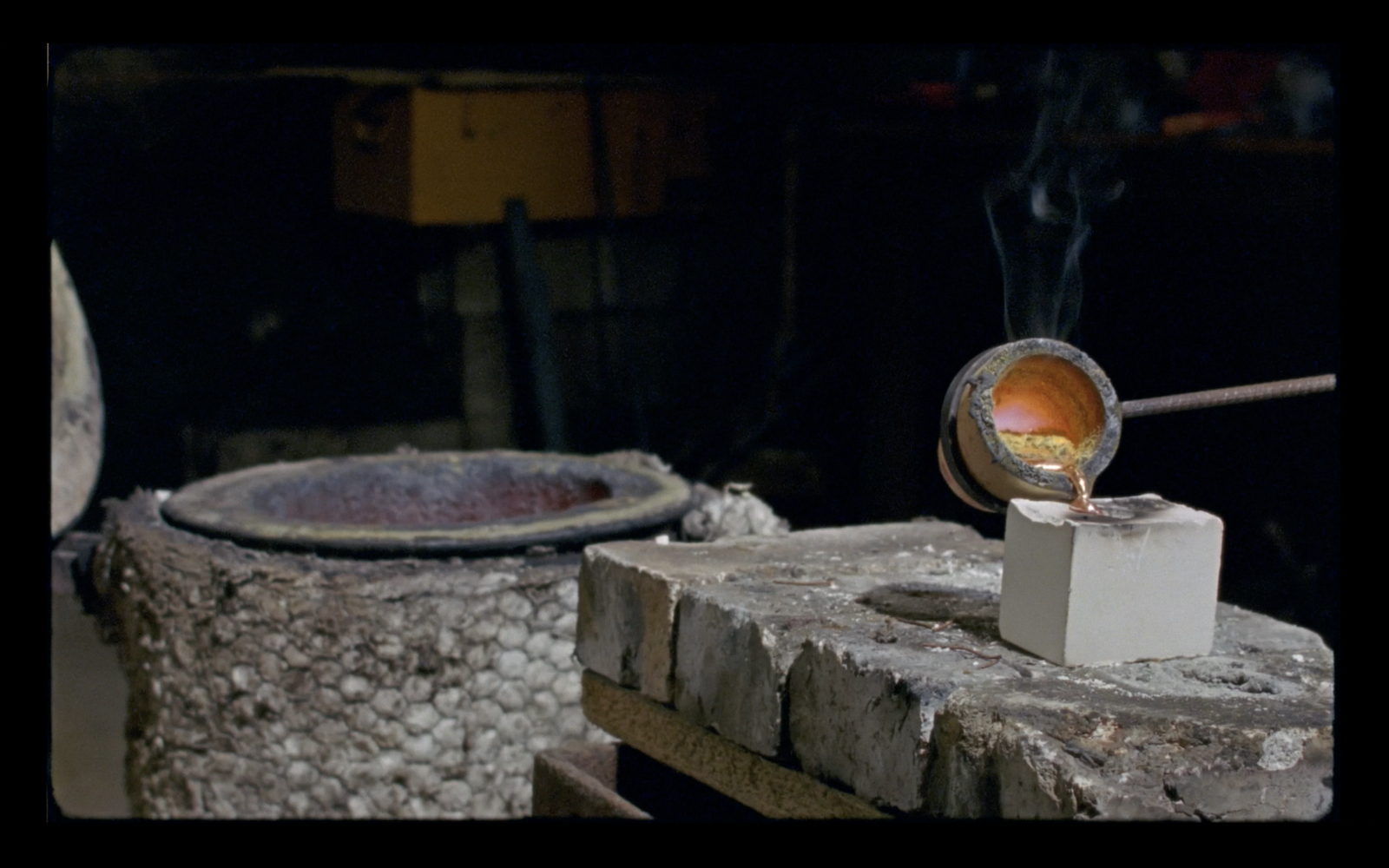
2'13'' - loop
Ed. 1/3
_
Editing : Laurent Montaron, Christophe Acker
With Jacques Perrault
Camera assistant : Lucas Léglise
Camera : Aaton XTR Prod
Film : 16 mm Kodak Vision3 200T 7213
Laboratory : Film Factory, Paris
Telecine : Blackmagic Cintel Film Scanner
_
https://vimeo.com/237715670
Password : mcluhan

Image: 110 x 160 cm
Figure pentagonale is the title of a set of six photographs, seemingly similar, but each with subtle differences. Each image features the same woman in two different positions, thus juxtaposing two temporalities: one draws a pentacle on the floor with chalk, while the other manipulates the carpet covering a theatre stage. Calling on the register of magic, the book in the photo assumes that it can influence the course of time by modifying fortune through chance, and in particular the probability of winning at games.
This series proposes a reflection on causality, and in particular on the existence of chance and fortune. Each small particularity of each photograph reflects different causalities, which suggests in a Pascalian conception that chance does not exist. Only the causality that originates in the future - fortune - is a key to explaining the present event.
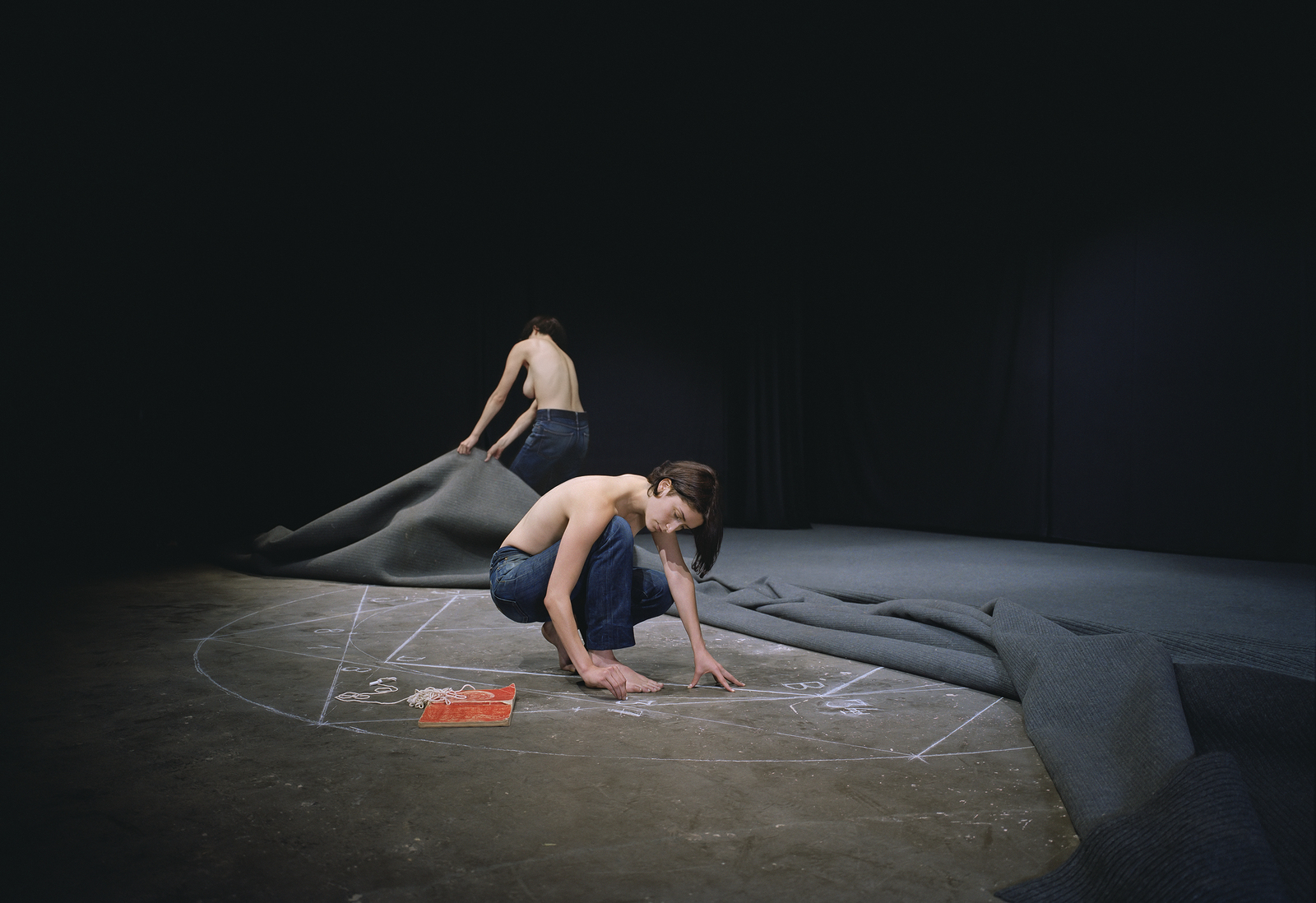
Image: 43 x 63 inches
Figure pentagonale is the title of a set of six photographs, seemingly similar, but each with subtle differences. Each image features the same woman in two different positions, thus juxtaposing two temporalities: one draws a pentacle on the floor with chalk, while the other manipulates the carpet covering a theatre stage. Calling on the register of magic, the book in the photo assumes that it can influence the course of time by modifying fortune through chance, and in particular the probability of winning at games.
This series proposes a reflection on causality, and in particular on the existence of chance and fortune. Each small particularity of each photograph reflects different causalities, which suggests in a Pascalian conception that chance does not exist. Only the causality that originates in the future - fortune - is a key to explaining the present event.
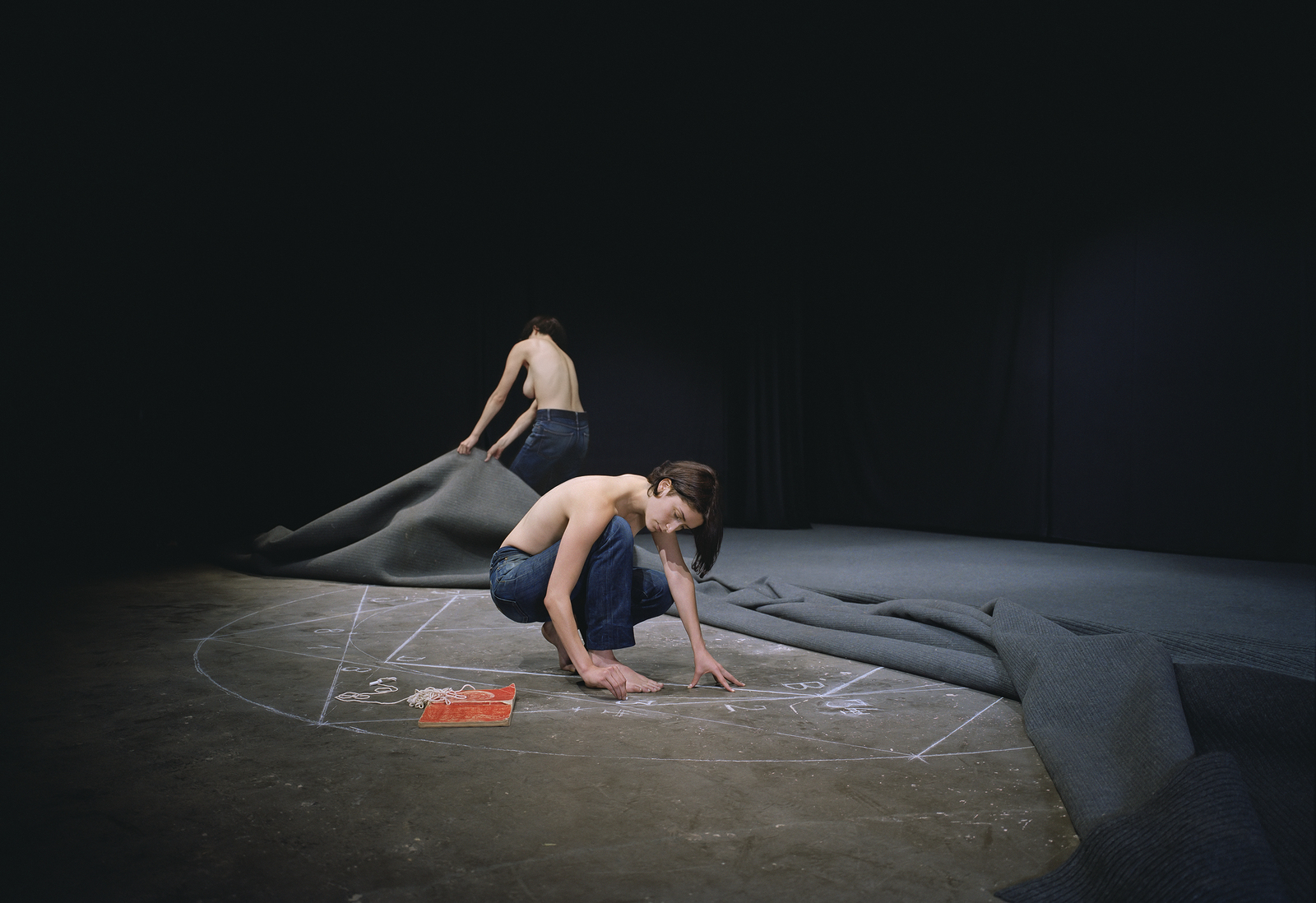
Image: 110 x 160 cm
Figure pentagonale is the title of a set of six photographs, seemingly similar, but each with subtle differences. Each image features the same woman in two different positions, thus juxtaposing two temporalities: one draws a pentacle on the floor with chalk, while the other manipulates the carpet covering a theatre stage. Calling on the register of magic, the book in the photo assumes that it can influence the course of time by modifying fortune through chance, and in particular the probability of winning at games.
This series proposes a reflection on causality, and in particular on the existence of chance and fortune. Each small particularity of each photograph reflects different causalities, which suggests in a Pascalian conception that chance does not exist. Only the causality that originates in the future - fortune - is a key to explaining the present event.
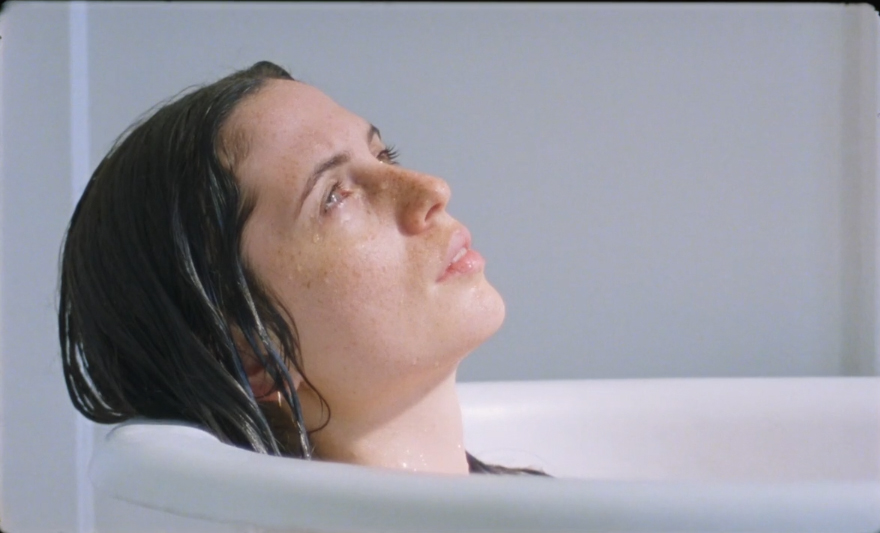
23'
Editing: Christophe Acker
First assistant camera: Lucas Léglise
Continuity supervisor: Mana Kikuta
Boom operator: Jeremy Ledda, Augustin Steyer
Technical advisor: Gordon Cyrus
Production: Sabine Tarry
Voice-over: Grace Atkinson, Dino Wiand
With Grace Atkinson, Marianne Dumet,
Lucas Léglise, Jacques Perrault, Goscha
Steinhauer, Anaëlle Vanel
Caméra: Aaton XTR Prod
Optics: Angénieux
Film stock: 16mm Kodak Vision3 50D 7203, Vision3
250D 7207, Vision3 200T 7213
Laboratory: Film Factory, Paris
Telecine: Blackmagic Cintel Film Scanner
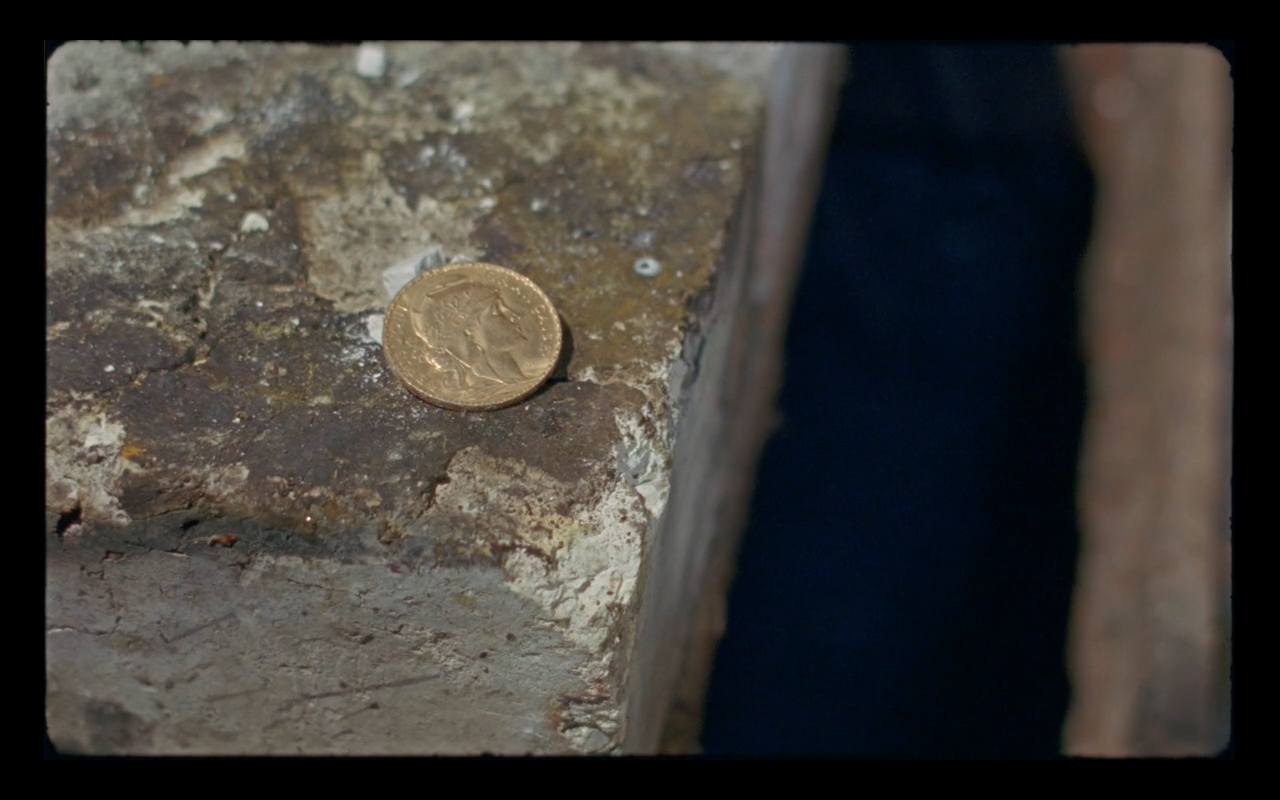
23'
Editing: Christophe Acker
First assistant camera: Lucas Léglise
Continuity supervisor: Mana Kikuta
Boom operator: Jeremy Ledda, Augustin Steyer
Technical advisor: Gordon Cyrus
Production: Sabine Tarry
Voice-over: Grace Atkinson, Dino Wiand
With Grace Atkinson, Marianne Dumet,
Lucas Léglise, Jacques Perrault, Goscha
Steinhauer, Anaëlle Vanel
Caméra: Aaton XTR Prod
Optics: Angénieux
Film stock: 16mm Kodak Vision3 50D 7203, Vision3
250D 7207, Vision3 200T 7213
Laboratory: Film Factory, Paris
Telecine: Blackmagic Cintel Film Scanner
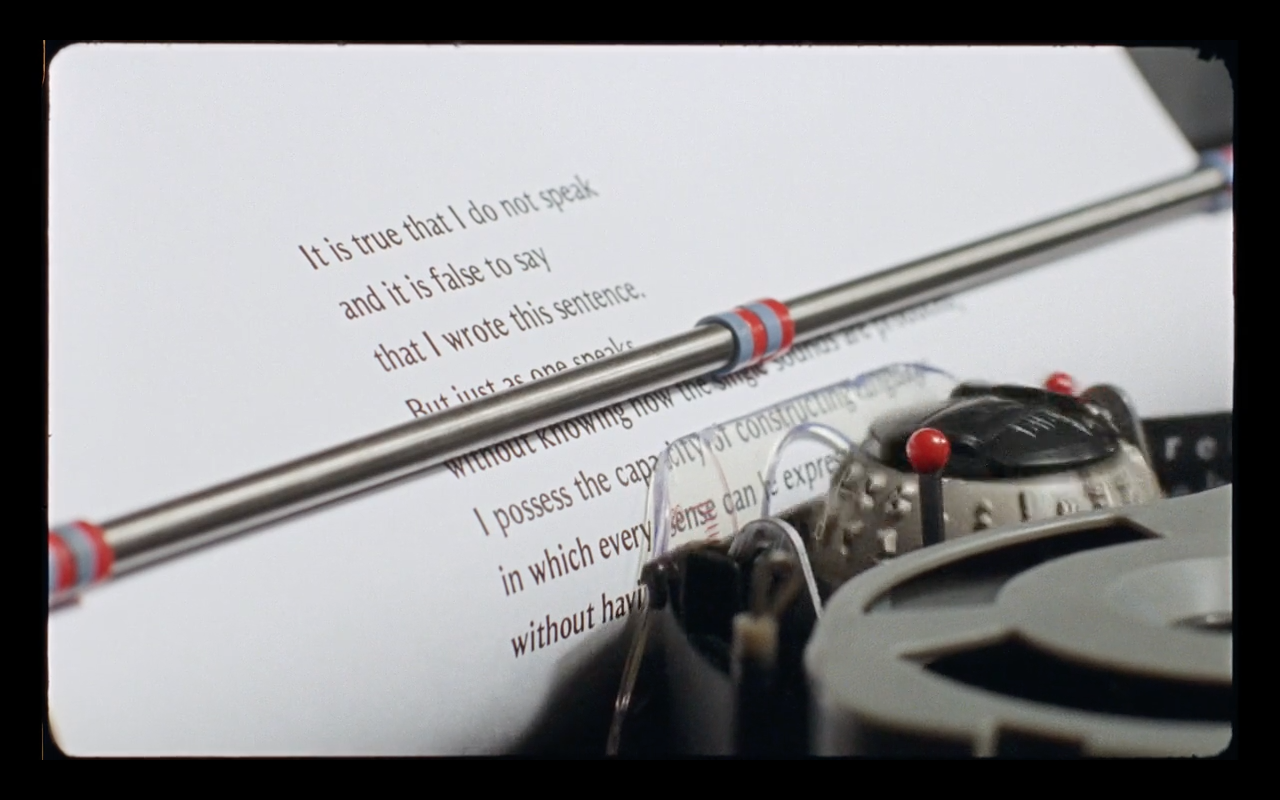
23'
Editing: Christophe Acker
First assistant camera: Lucas Léglise
Continuity supervisor: Mana Kikuta
Boom operator: Jeremy Ledda, Augustin Steyer
Technical advisor: Gordon Cyrus
Production: Sabine Tarry
Voice-over: Grace Atkinson, Dino Wiand
With Grace Atkinson, Marianne Dumet,
Lucas Léglise, Jacques Perrault, Goscha
Steinhauer, Anaëlle Vanel
Caméra: Aaton XTR Prod
Optics: Angénieux
Film stock: 16mm Kodak Vision3 50D 7203, Vision3
250D 7207, Vision3 200T 7213
Laboratory: Film Factory, Paris
Telecine: Blackmagic Cintel Film Scanner
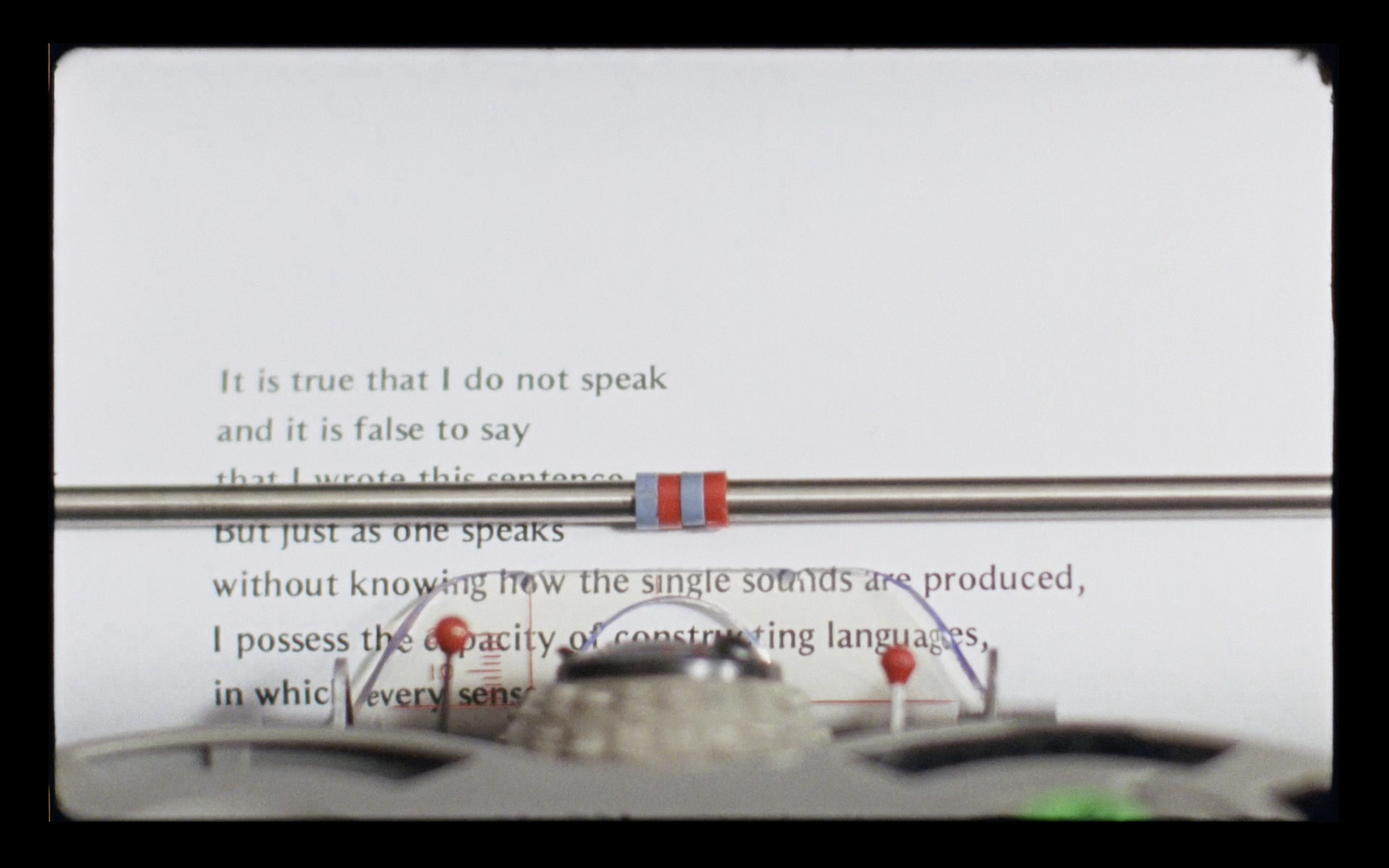
3'03''
Ed. 2/3
_
Editing : Laurent Montaron
Camera assistant : Lucas Léglise
Technical advisor : Gordon Cyrus
Camera : Aaton XTR Prod
Film :16mm Kodak Vision3 200T 7213
Laboratory : Film Factory, Paris
Telecine : Blackmagic Cintel Film Scanner
_
https://vimeo.com/193912973
mot de passe : mcluhan
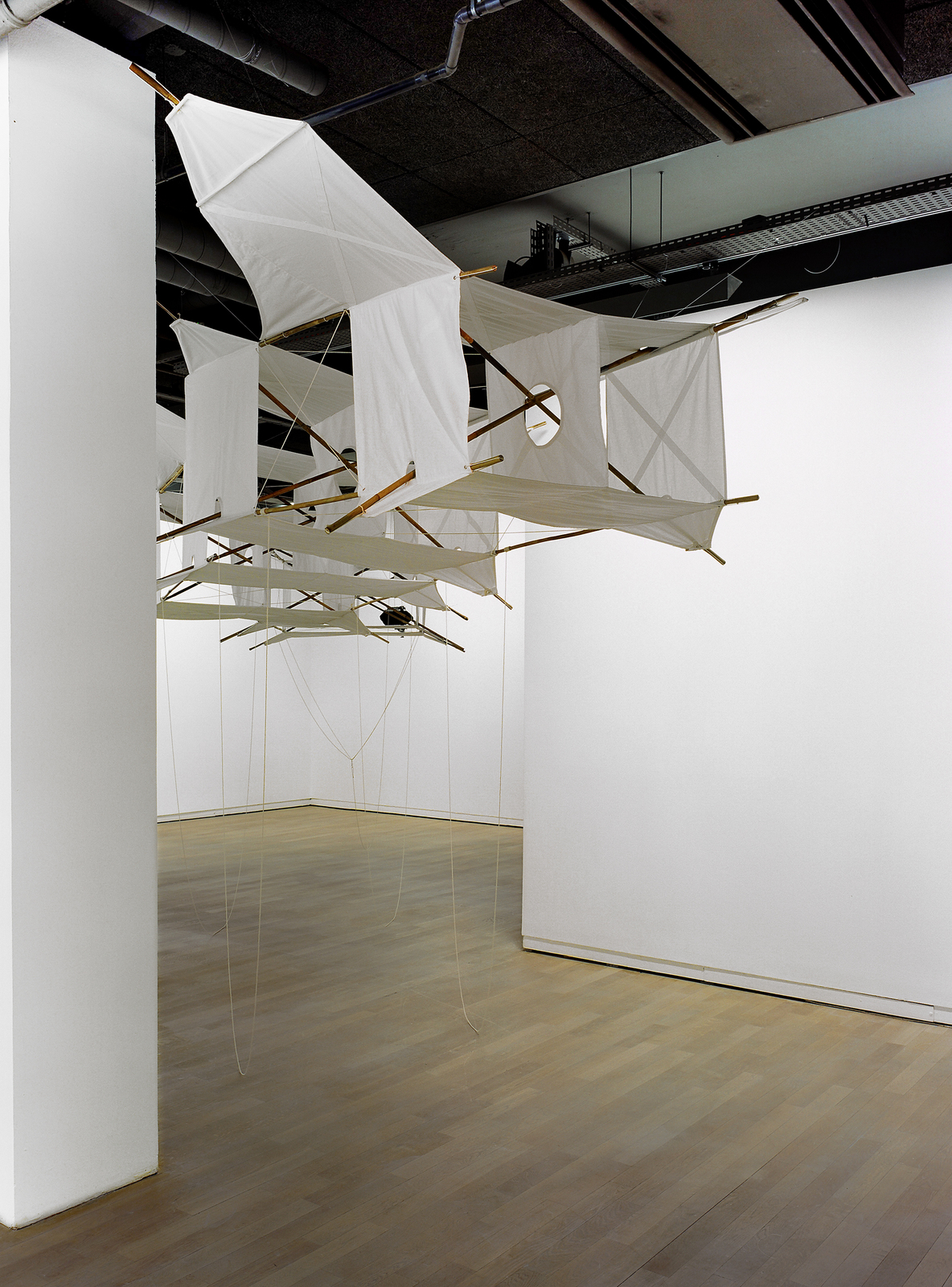
each kite: 122 x 71 x 39 inches
© André Morin
Durant la Première Guerre mondiale, le scientifique Jacques-Théodore Saconney élabore une méthode de prise de vue aérienne atypique, fonctionnant grâce à des cerfs-volants. Dans Train de cerfs-volants Saconney, Laurent Montaron reprend cette invention, ancêtre du drone, créant ainsi un retour sur l'histoire de la technologie ayant permis la transformation de notre vision du monde.
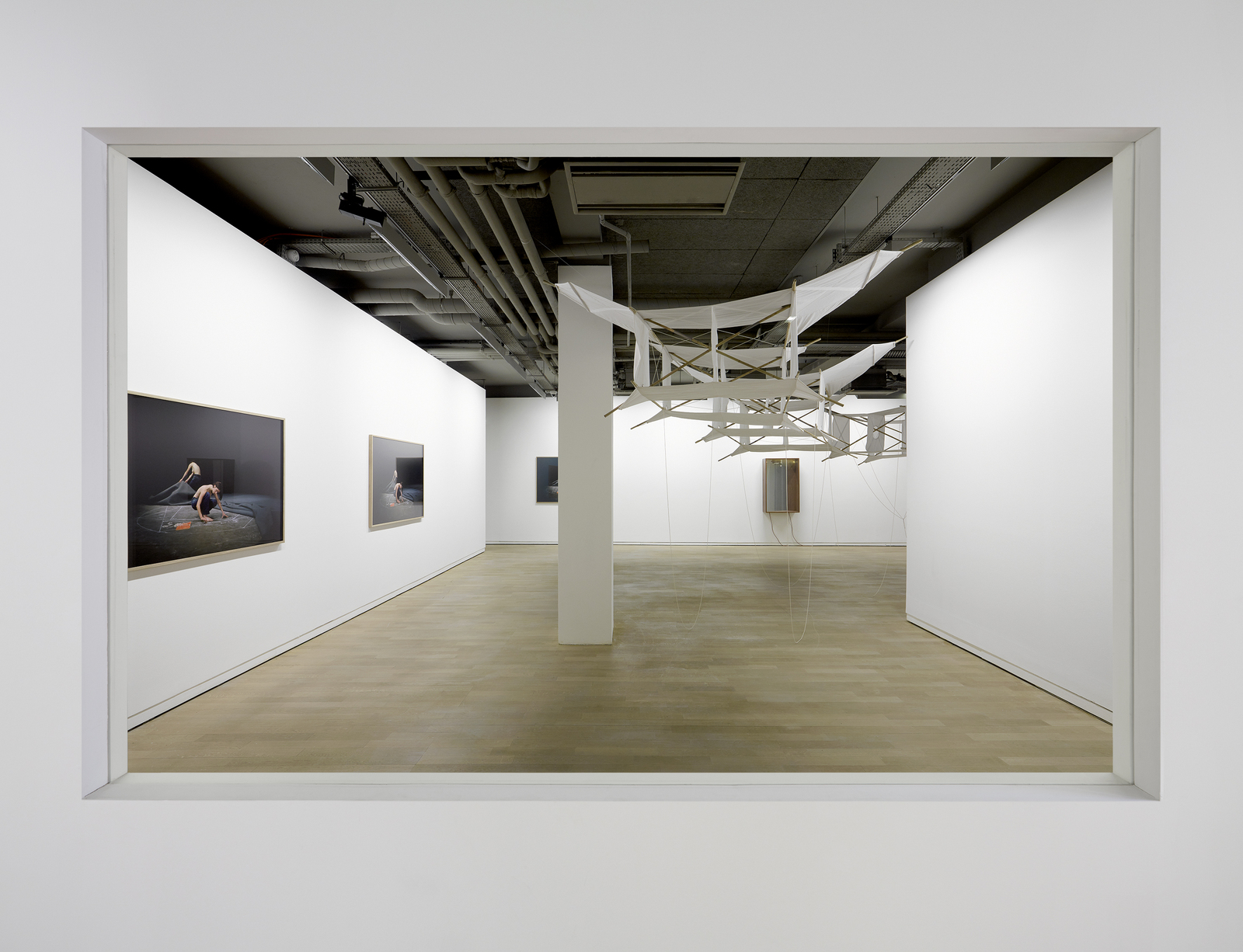
each kite: 122 x 71 x 39 inches
© André Morin
Durant la Première Guerre mondiale, le scientifique Jacques-Théodore Saconney élabore une méthode de prise de vue aérienne atypique, fonctionnant grâce à des cerfs-volants. Dans Train de cerfs-volants Saconney, Laurent Montaron reprend cette invention, ancêtre du drone, créant ainsi un retour sur l'histoire de la technologie ayant permis la transformation de notre vision du monde.
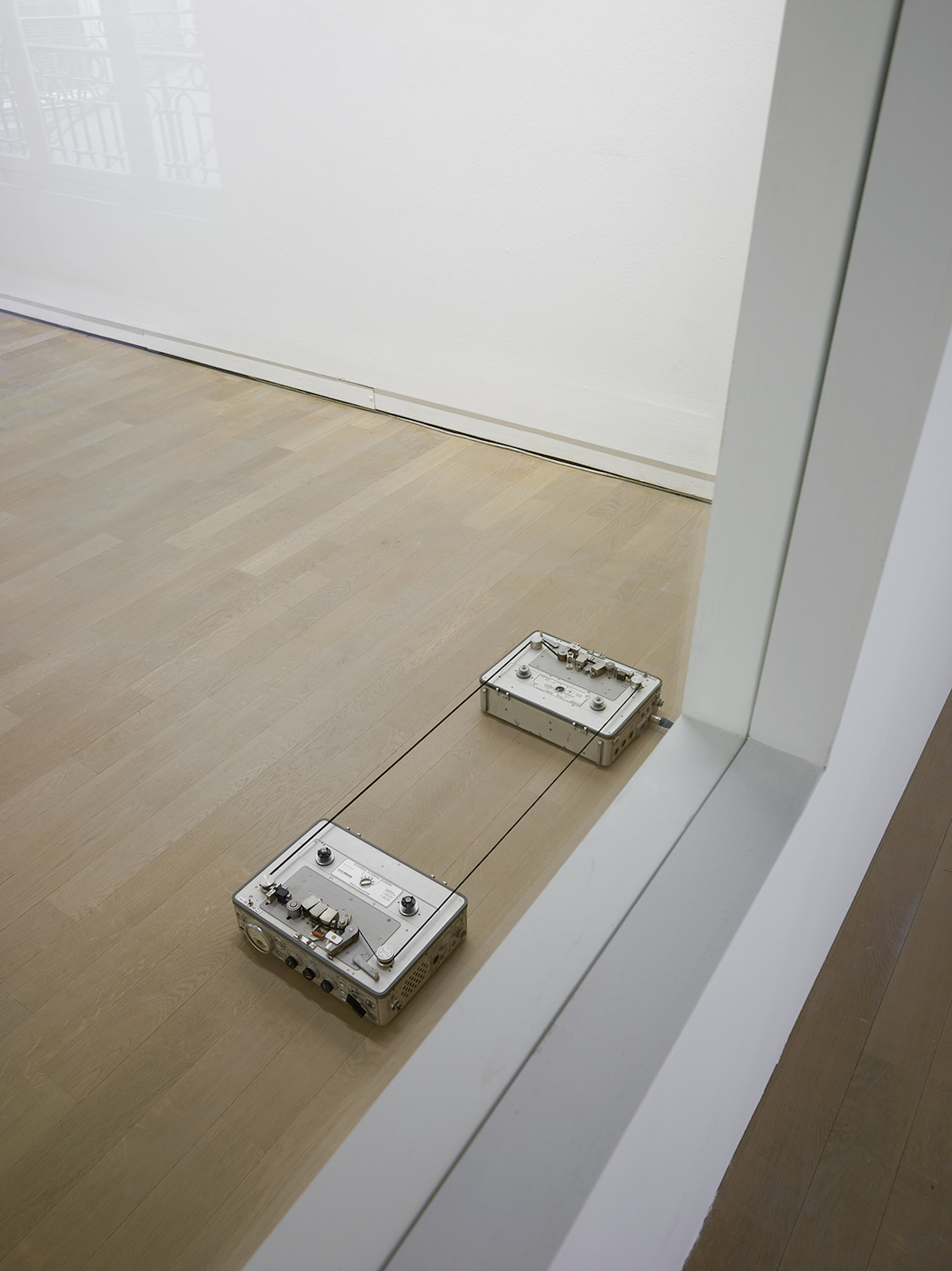
Variable dimensions
View of the exhibition ''Dioramas'', Fondation d'entreprise Ricard, Paris, France, November 14 - January 7, 2017
© Marc Domage
A magnetic tape is looped between two portable analogue audio recorders, the Nagra IV-S, and the Nagra 4.2. While one records, the other broadcasts, creating a delay aired sound, a short echo that overlaps the ambient sounds.

Image: 95 x 120 cm
© Laurent Montaron
Ondes Martenot depicts the interpretation of a musical piece composed by Olivier Messiaen, "Fêtes des belles eaux, II/14 : Oraison," written in 1937. The photograph was taken during the eight-minute-long performance by Claude-Samuel Lévine. The Ondes Martenot was the first electronic instrument to be introduced into an orchestra. It was invented in 1928.
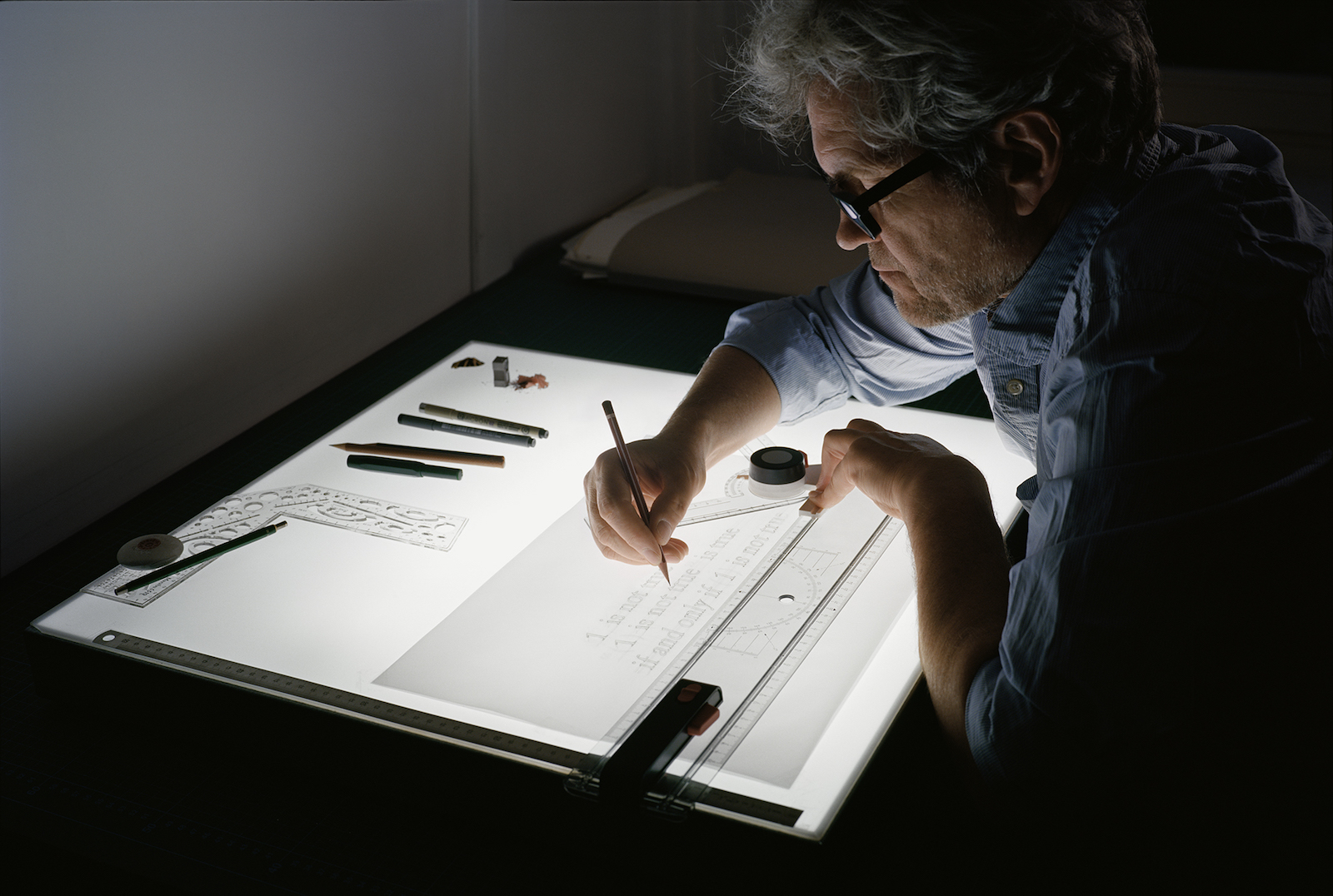
Pigment print
Image: 63 x 42 inches
Revision Theory of Truth is a series of photographs in which a man sits at a light box where he stencils text. The photographs seem almost identical, except that the man's hand adopts a slightly different position and the text changes. The inscribed sentences invite us to question the notion of truth and propel us on a Möbius strip, according to the model of the famous paradox of the liar: if I affirm that I lie, do I tell the truth?

Pigment print
Image: 63 x 42 inches
Revision Theory of Truth is a series of photographs in which a man sits at a light box where he stencils text. The photographs seem almost identical, except that the man's hand adopts a slightly different position and the text changes. The inscribed sentences invite us to question the notion of truth and propel us on a Möbius strip, according to the model of the famous paradox of the liar: if I affirm that I lie, do I tell the truth?
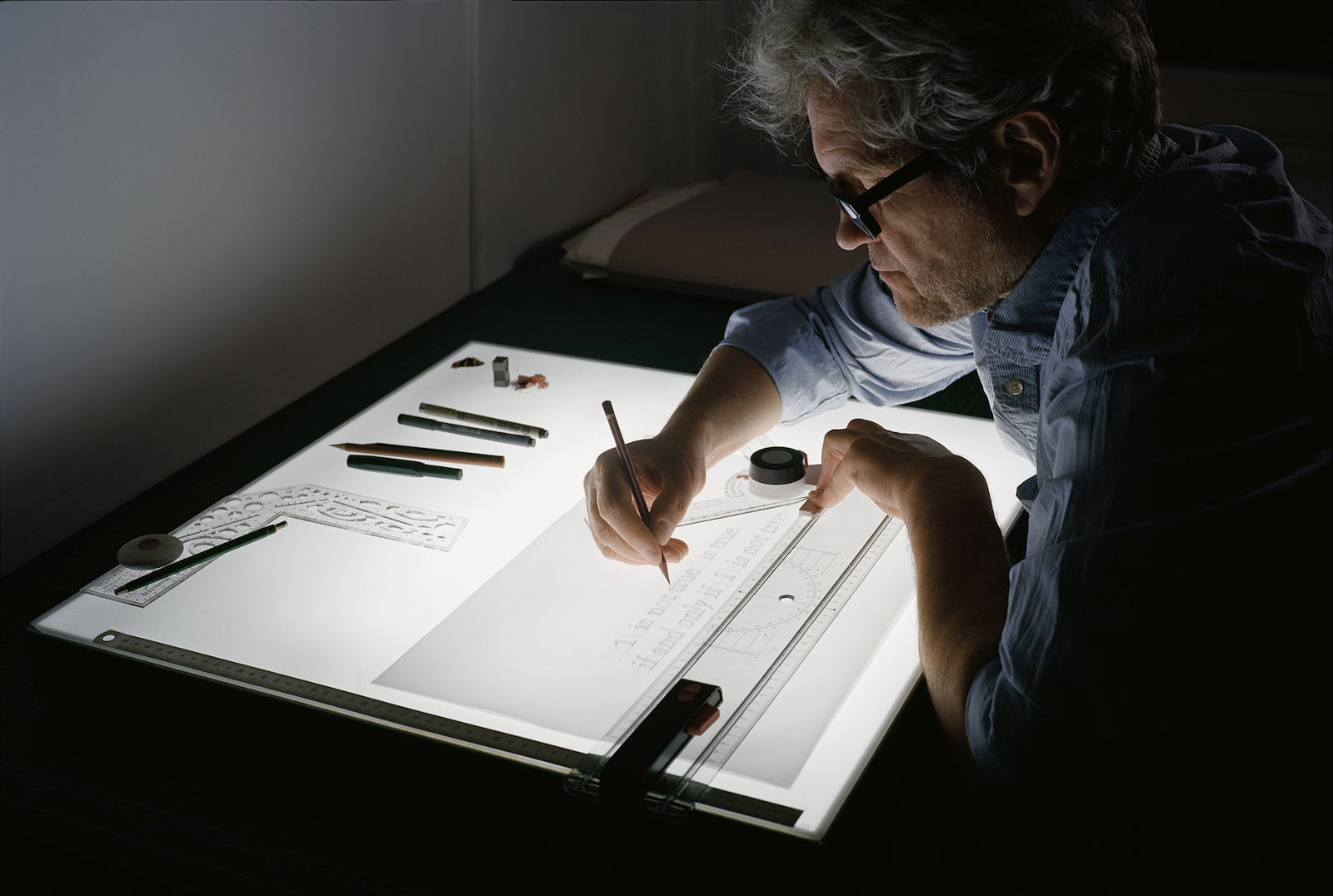
Pigment print
Image: 63 x 42 inches
Revision Theory of Truth is a series of photographs in which a man sits at a light box where he stencils text. The photographs seem almost identical, except that the man's hand adopts a slightly different position and the text changes. The inscribed sentences invite us to question the notion of truth and propel us on a Möbius strip, according to the model of the famous paradox of the liar: if I affirm that I lie, do I tell the truth?
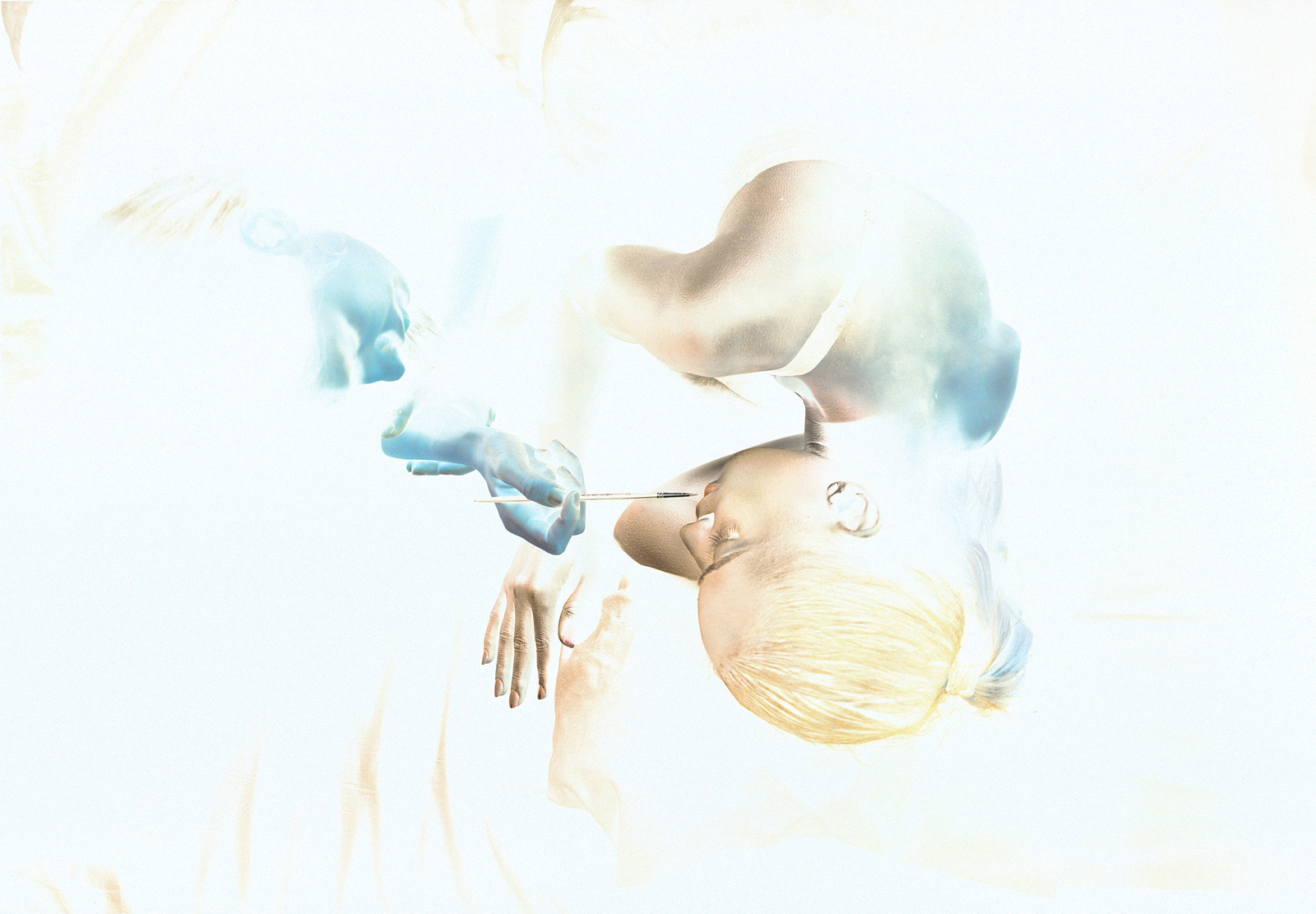
C-41 is a photography inspired by the work done on the film of Henri-Georges Clouzot L'Enfer. In the film, one the two main character Serge Reggiani is drowning in a morbid jealousy delirium. For some scenes, Clouzot decides to use make up to render his hallucinations, therefore Romy Schneider appear on some scene with a make up inverted, with blue-green lips, which would have been used as an inverted color scene. The film has never been finished as Clouzot died before its end. This photography is using the process from the makeup to the inversion. The complementary colors inverted shows the face of the character in the right color as the all over parts are seen as negative.

Image: 160 x 105 cm
Kalender is a color photography showing a kid drawing on his leg a mnemotechnic scale of time, the image underlines the place of the analogy in the constitution of the memory.
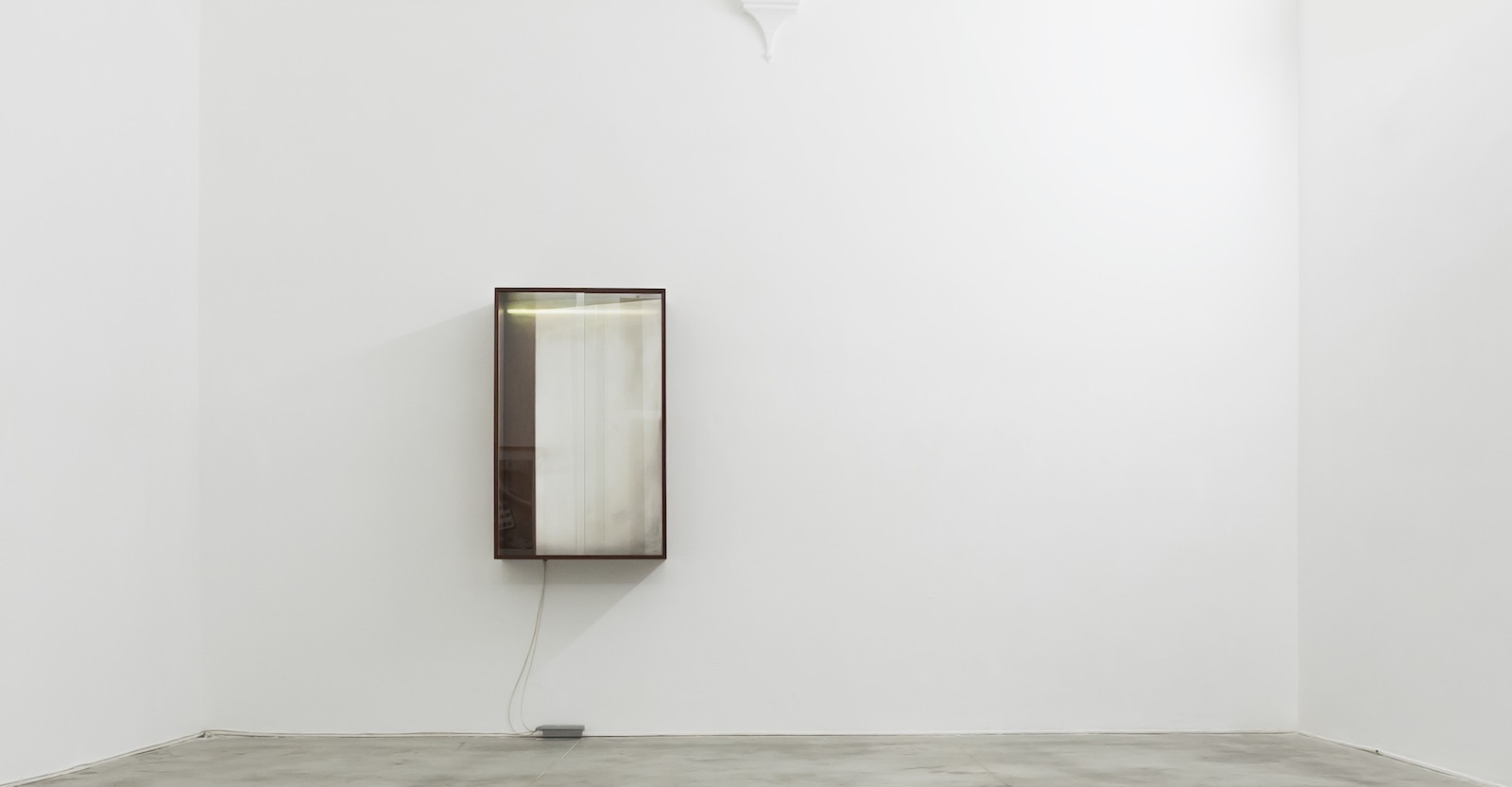
49 x 31,6 x 13,6 inches
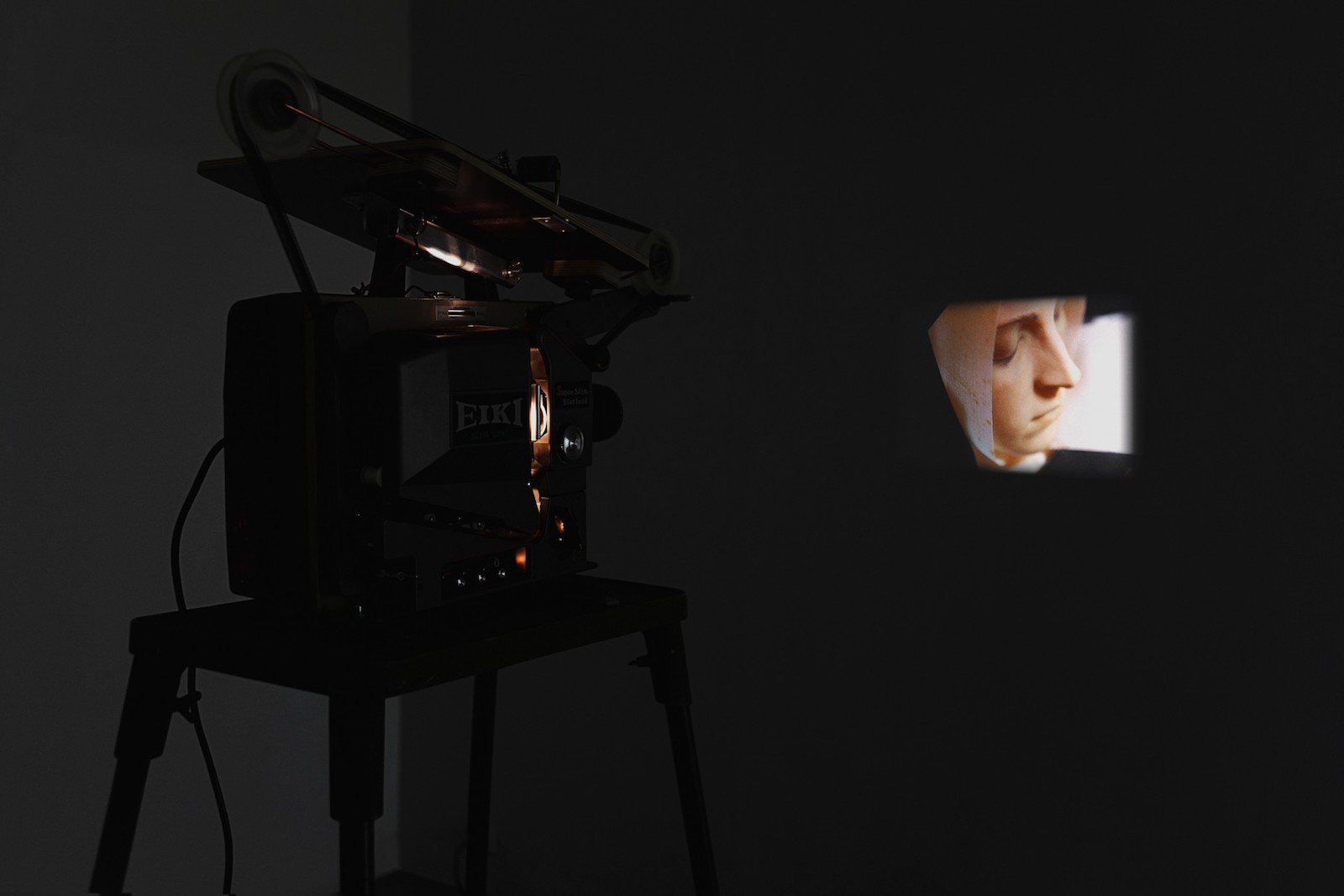
1.37 : 1 aspect ratio
Lent portrait de Sainte Bernadette is a slow-motion loop, with the camera executing a slow focus on the saint's mouth to her eyes. The intact body of St Bernadette - it shows no signs of decomposition - seems frozen in time since she died in 1879 in Nevers, France, where it still lies. Bernadette was beatified on 14 June 1925 and canonised on 8 December 1933.
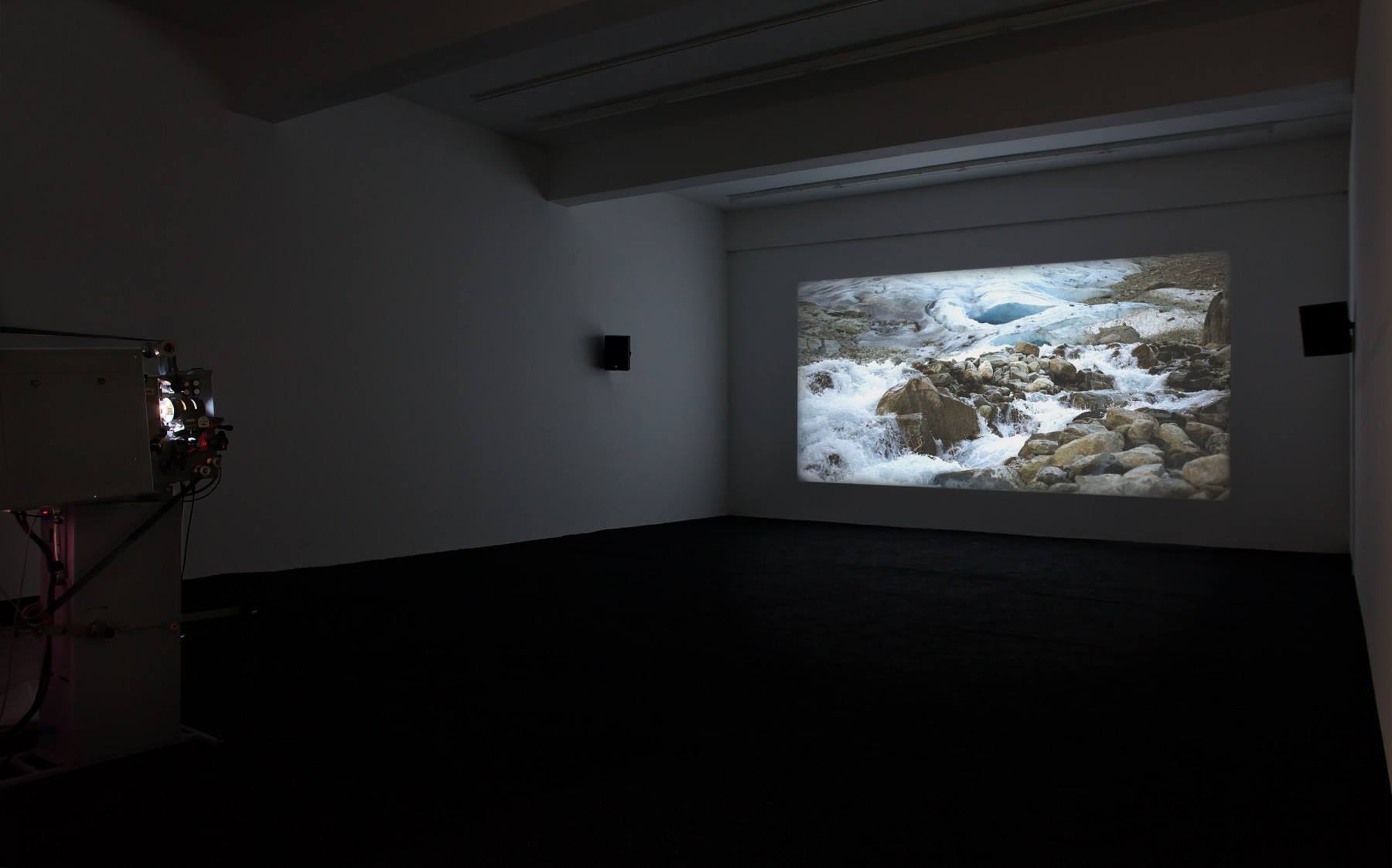
1:1.85, Dolby SR, 10'56''
In the film Short study on the nature of things a female narrator recorded to tape tells stories remembered from her childhood; how she shaped her personal understanding of the world, space and time. The narrative is interwoven with axioms from Heraclitus and accompanies a series of images of instruments of measurement and representation of light and time, and others including the melting of a glacier and the incorrupt body of St Bernadette of Lourdes. The title is a direct reference to Lucretius Latin poem De Rerum Natura: on the nature of things.
https://vimeo.com/60747100 (password : macluhan)
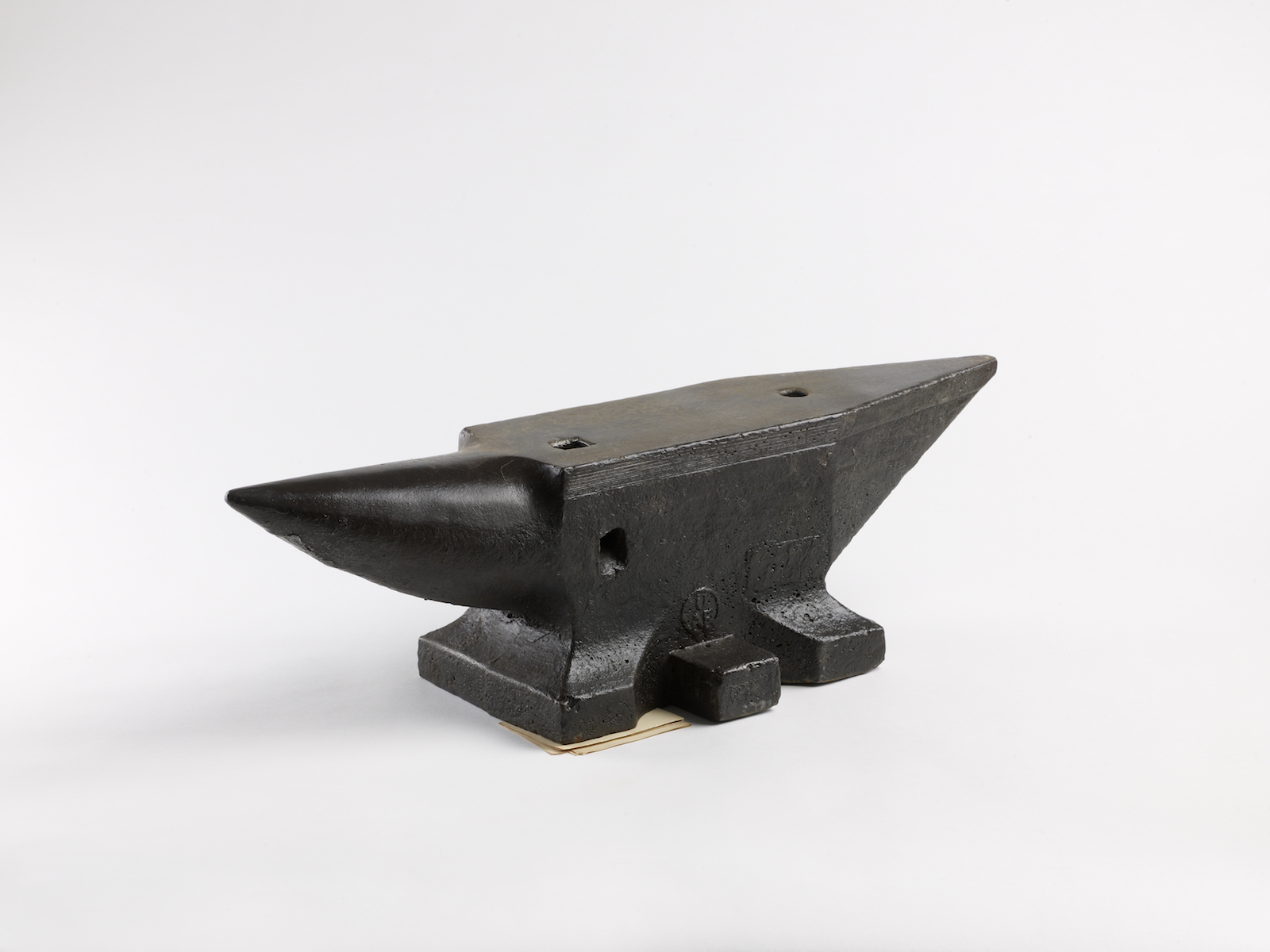
11 x 27,5 x 8,6 inches

202,4 x 118 x 19,7 inches
View of the exhibition ''Pace'', Kunsthaus Baselland gallery, Muttenz/Basel, Switzerland, January 21- March 21, 2010
Phoenix is an installation consisting of a stage made of plywood sheets laid on red bricks, where a wax cylinder phonograph is placed. Once activated, the recorded voice of someone speaking in tongues is broadcast. Mentionned in the New Testament's Acts of the Apostles, speaking in tongues is a form of praying that is performed aloud in a language unknown to the speaker ; it is practiced most notably in Methodist churches.

Image: 127 x 187 cm (each)
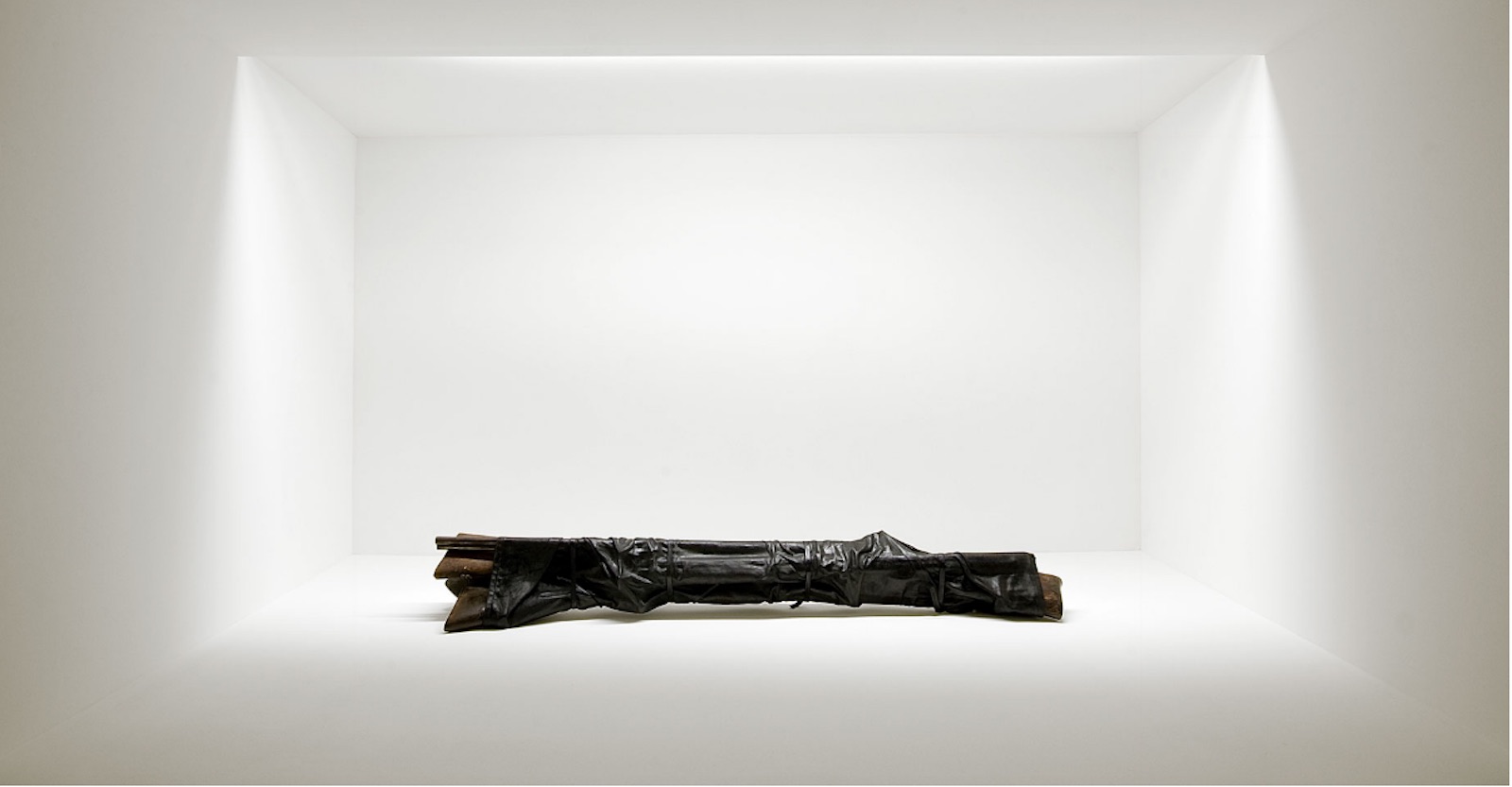
55 x 9,8 x 9,8 inch
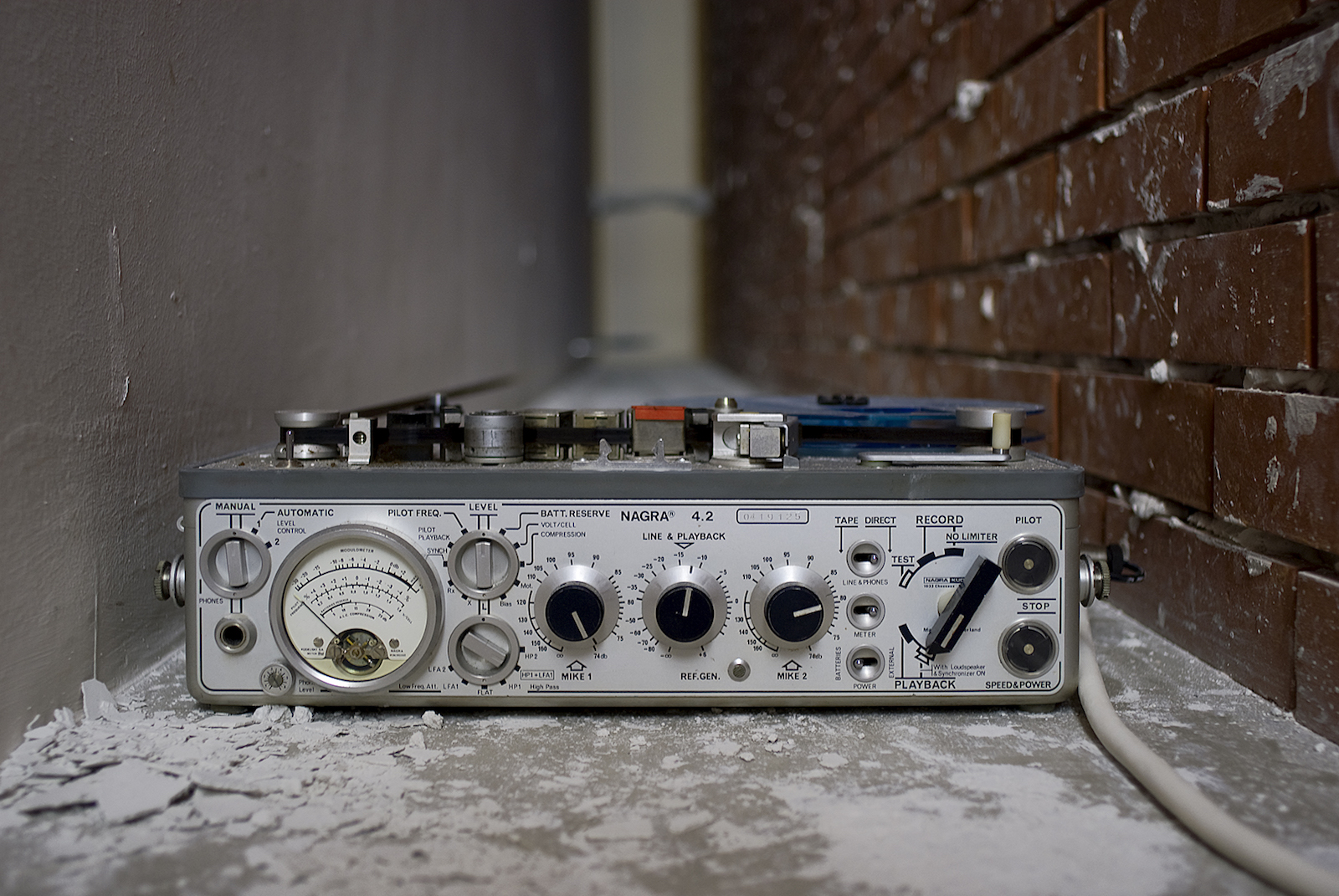
Variable dimensions
The installation Silent Keys consists of the broadcasting of a Morse code message through the entire exhibition space. The message, whose tape recorder is hidden behind a brick wall built on one side of the room, stops short once someone enters the space. The message comes from an amateur radio operator, an acknowledgement of the French government's call to suspend all communication during the attempted army putsch in Algeria in 1961. Silent Key is a reference to the termination of transmission: the Morse key has gone silent.

Two movies HD synchronized with color and sound
11'49''
© Blaise Adilon
Work realised for the exhibition Laurent Montaron at l'Institut d'art contemporain, January-March 2009
Co-production Institut d'art contemporain / FRAC Champagne-Ardenne
Producer : A.D.N. Factory ; Christine Acker, Nicolas Duroux, Agathe Nony
Image manager : Georges de Genevraye
First assistant production : Magalie Meunier
Camera assistant : Raphaël Palin
Electronic : Pierre Palle
Electronic assistant : Frédéric Prémoli
Sound engineer : Jocelyn Robert
Assistant, decoration : Claire Jolly, Nicolas Planno
Actor : Daman Chambon
Editing : Christophe Acker, Anouschka Czmil
Film-set photographer : Christelle Montaron
Exhibition :
- Laurent Montaron, IAC Villeurbane/Rhône Alpes, France, 2009
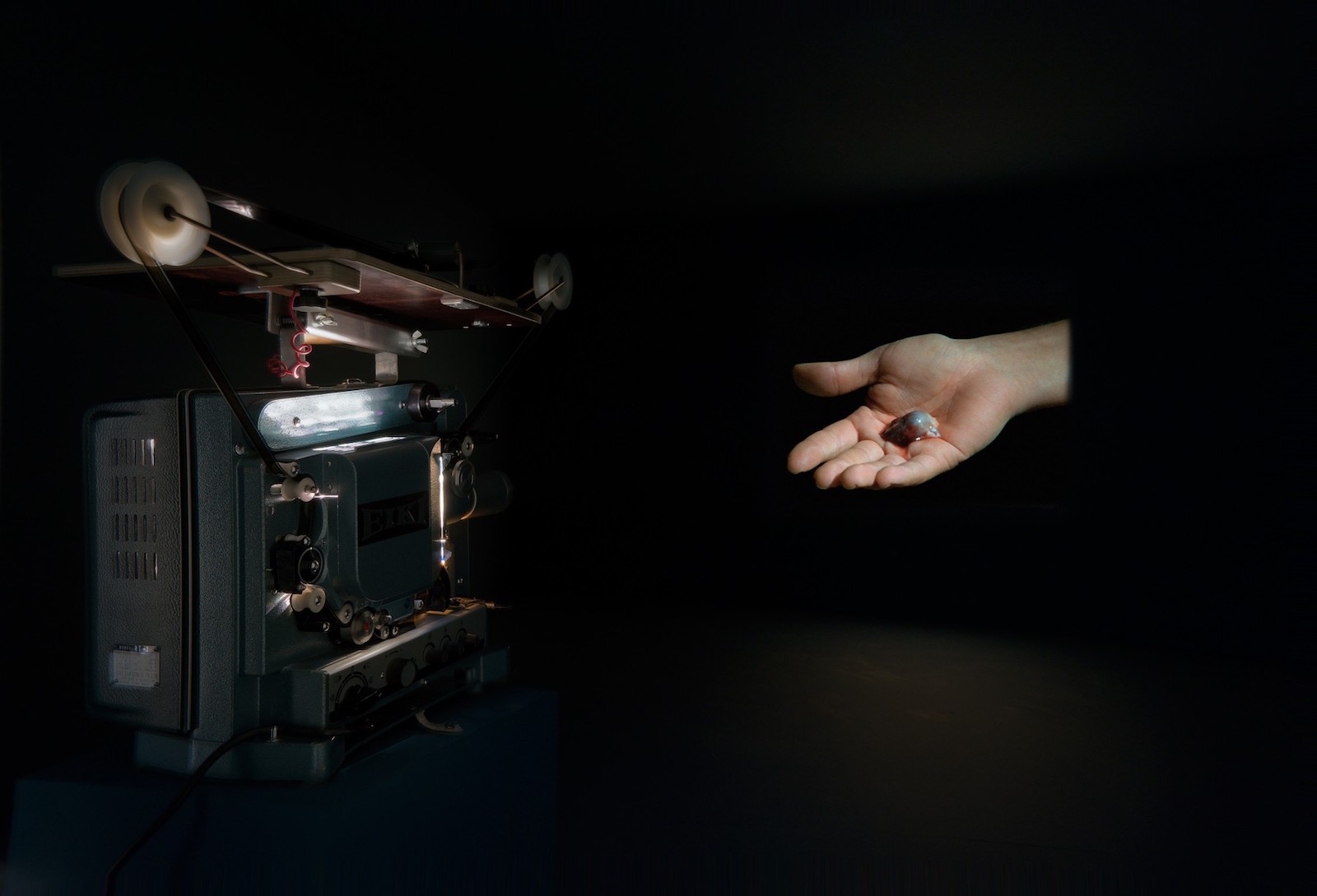
Variable dimensions
Pace is a 16mm film loop screened inside a vitrine built in a wall. The film shows a carp's heart beating endlessly in the palm of a hand as the photographic film itself gradually wears out.
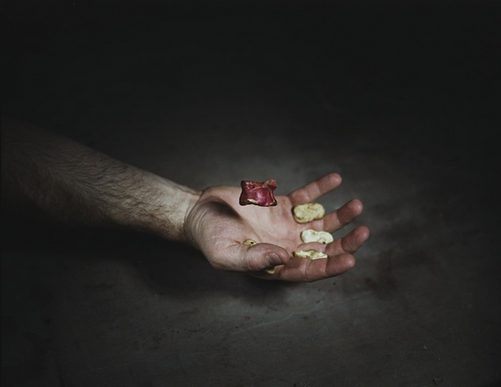
Image: 54,5 x 70 inch
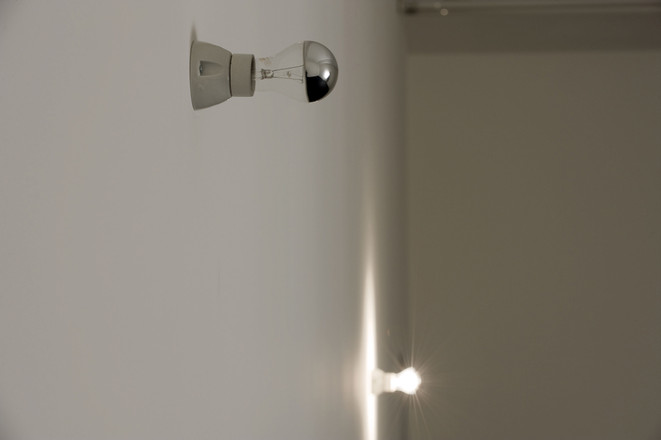
Variable dimensions
View of the exhibition Laurent Montaron, Institut d'art contemporain, Villeurbanne/Rhône-Alpes, France, 2009
© Blaise Adilon
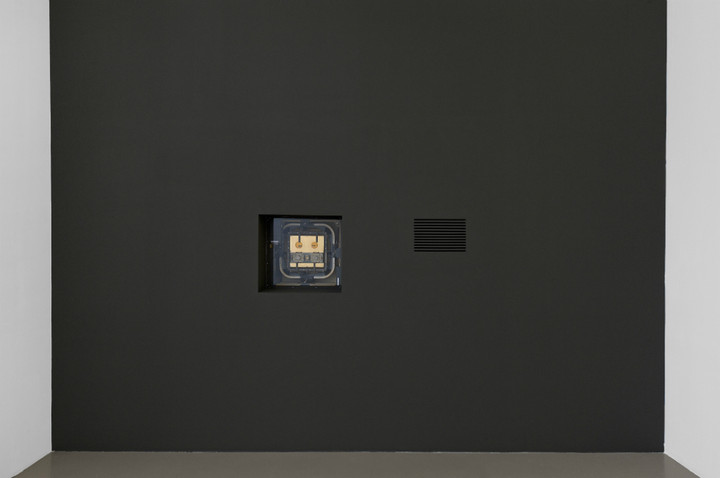
© Blaise Adilon
Analogie de la ligne s'inscrit dans la série des pièces que Laurent Montaron qualifie d'« objets-images » ou de « readymades aidés », et qui ont pour point commun l'appropriation de matériel acoustique des années soixante et soixante-dix. Il s'agit ici d'une chambre de réverbération à plaque d'or, dispositif d'amplification du son utilisé dans les studios d'enregistrement avant l'ère du numérique. Ce dispositif permet de simuler un effet de réverbération spatiale dont sont dépourvus les enregistrements en studio, la vibration d'une feuille d'or permettant de recréer artificiellement la sensation sonore d'un espace large.
Dans Analogie de la ligne, le caractère daté de cet équipement se complète d'une dimension mystérieuse et magique. Celle-ci est liée à l'étrangeté de la machine, mais également à la feuille d'or, visible derrière la paroi de verre, et qui renvoie à l'imaginaire des icônes ou des saintes reliques. Le titre, qui fait référence à l'Allégorie de la caverne de Platon, la spatialisation du dispositif placé au fond d'un corridor, et le phénomène d'amplification de la voix sont autant d'éléments qui confèrent à cette pièce un caractère oraculaire.
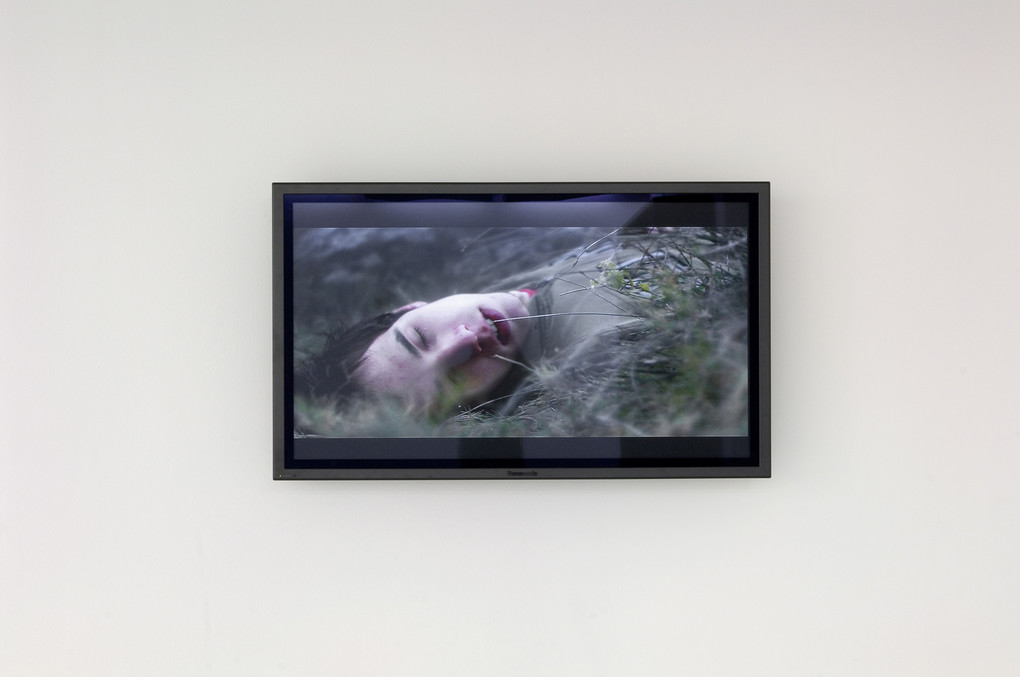
Rounded with a sleep relates the wanderings of a group of teenagers in a desert moor countryside. This isolated group engages in an initiatory experience which fosters hallucinations and disorientation. The ever blowing wind, and the sound of breathing, punctuate the whole performance. This, little by little, throws us in turn into a confusion between the various intertwining temporalities and points of view within the film.

5'23''
Le film évoque un récit d'anticipation à travers le voyage d'un ballon dirigeable en feu.
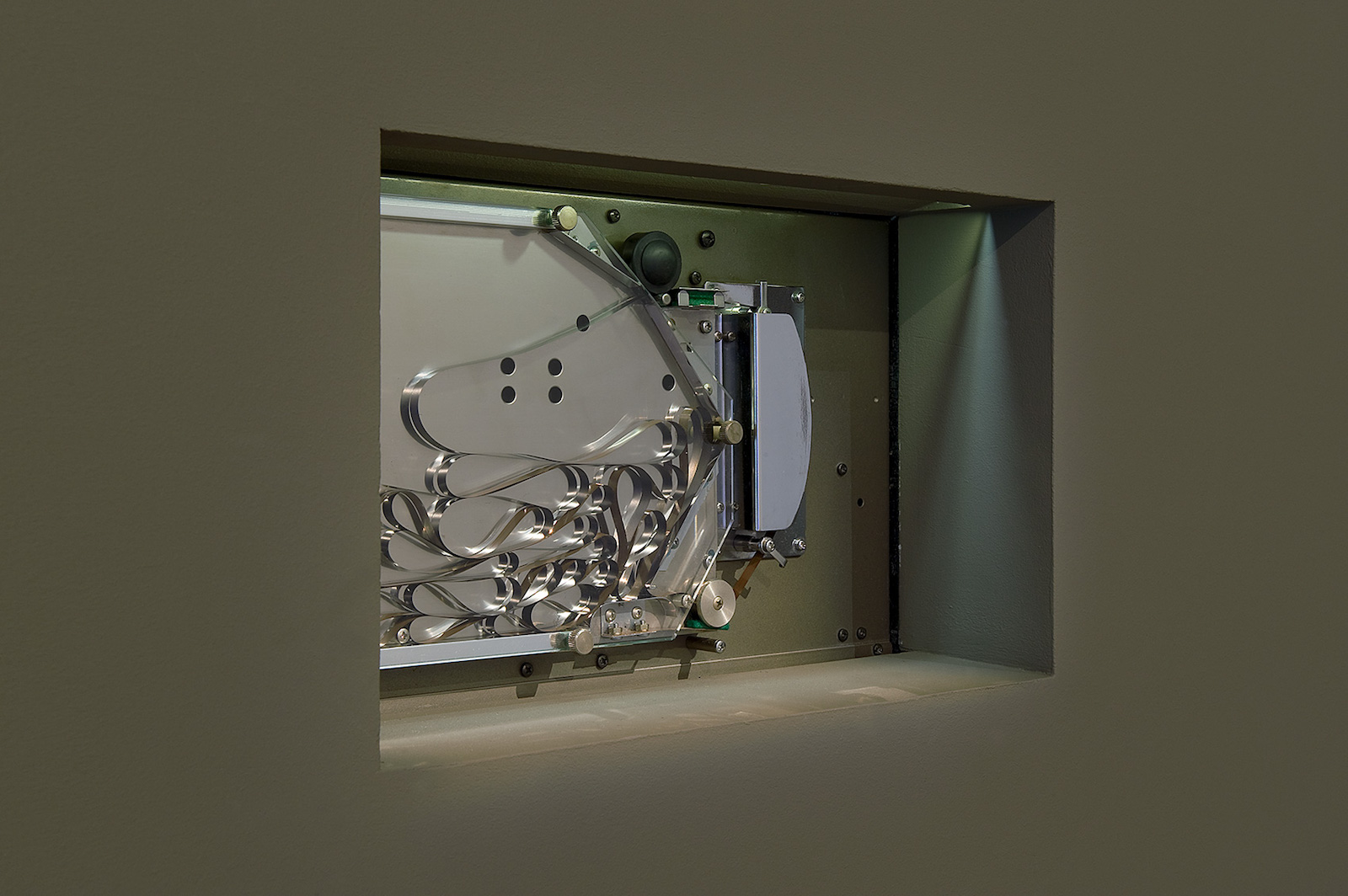
Variable dimensions
Melancholia is a modified Roland RE-201 Space Echo.
This tape echo effect unit is used in recording studio environments to enhance a sound, a voice, or an instrument by providing a recording or a broadcast with an echo of varying duration. A magnetic tape loop a few seconds long is used for the recording process. Played back across several tape heads in succession and varying speeds, the tape creates a distinctive analog echo. Set vertically into a wall, the device functions silently, thus focusing the viewers' attention to the scroll-shapes formed by the tape.
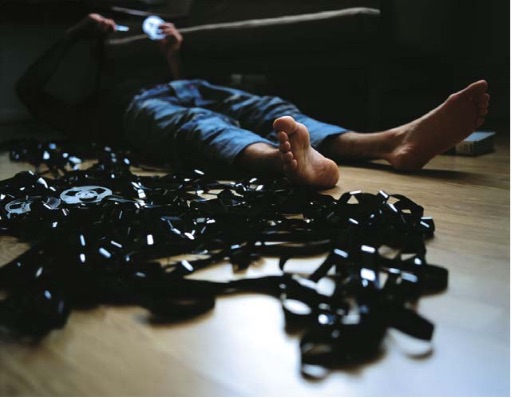
Image: 48,8 x 53 inch
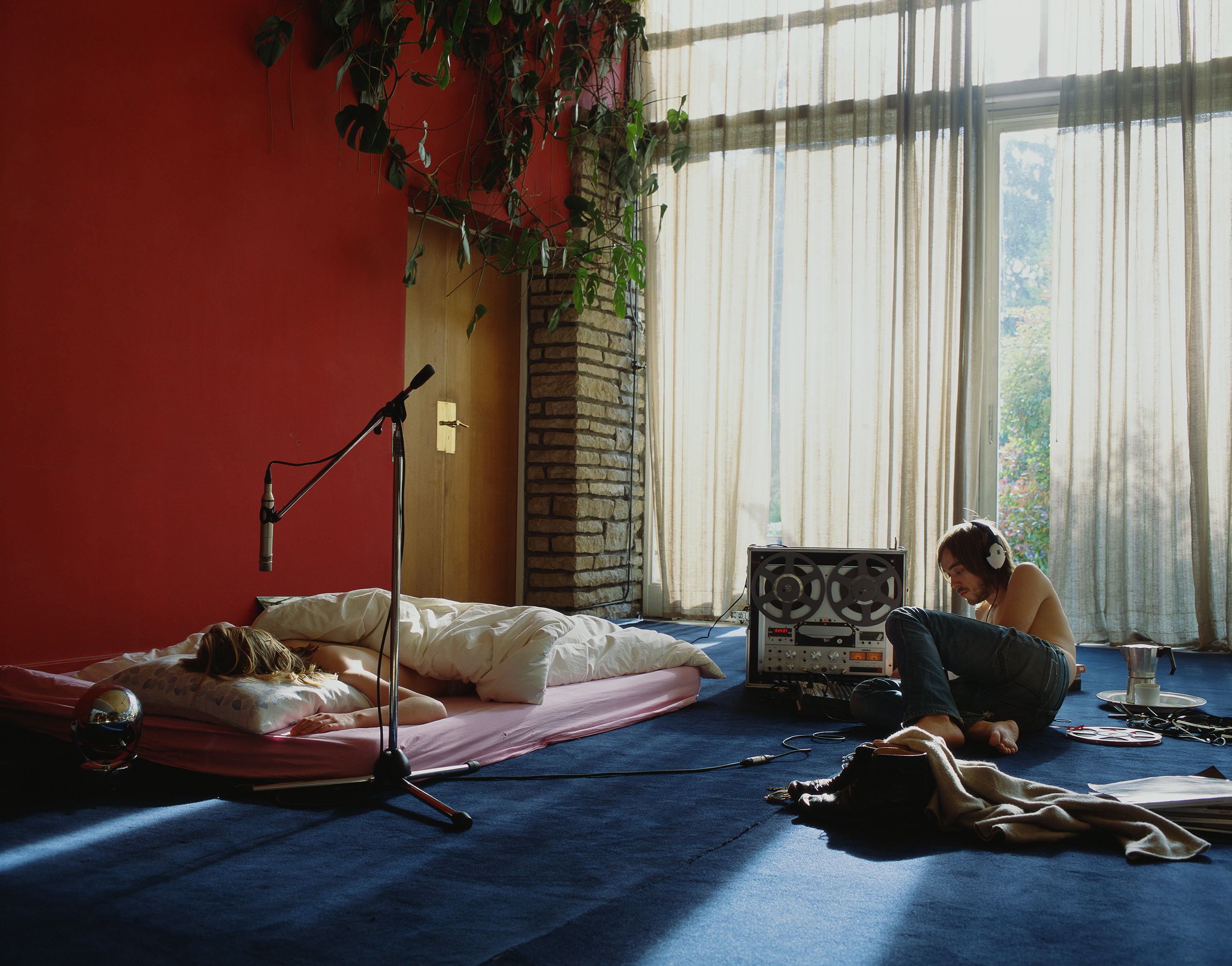
Image: 180 x 230 cm
Somniloquie consists of a photograph and a series of vinyl records whose fragile engravings on dub plates fade as the audience listens to them. The vinyls are recordings of someone talking in her sleeps.
With Somniloquie, it is parapsychism that the artist puts to contribution. The image represents a curious scene: a young man listens, by means of a headset connected to an imposing tape recorder, a Studer-Revox PR99, to the words, captured by a microphone, that are pronounced by a woman who sleeps two steps away from him. Somniloquy has an artistic past: the experiment of hypnotic sleep, carried out in 1922 by Crevel, Desnos, Péret, and told by Breton in Les Pas perdus.

Variable dimensions
Produced from the 1940s to the 1980s to provide sound for cinemas, Altec Lansing A8 speakers were designed to deliver powerful and clear sound while remaining invisible, placed just behind the screens.
"Voice of the Theatre" is an installation in which a speaker emits two slightly different notes generated live by frequency oscillators. By synchronizing and then desynchronizing, the sound from the speakers produces a beating that forms a looping pattern in the exhibition space.
Laurent Montaron (b. 1972 Verneuil sur Avre, lives and works between Saulchery and Paris) is an interdisciplinary artist working across film, photography, installation, sound and performance. His works draw from the history of technology to examine systems of belief, investigating the ways in which innovations have continually given rise to new ways of observing and understanding the world. Through his critical invistigations of the media and tools that shape our representations, his work lays bare the paradoxes that accompany our awarness of modernity.
He has participated in numerous exhibitions internationally including: EPPUR SI MUOVE, MUDAM, Luxembourg, 2015; You imagine what you desire, 19th Biennale of Sydney, 2014; The Encyclopedic Palace, 55th Venice Biennale, 2013; Open End- Goetz Collection, Haus der Kunst, Munich, Lost in LA, Los Angeles Municipal Art Gallery, Barnsdall Art Park, Los Angeles, all 2012.